If you’re wondering what to buy in Japan, this is the guide for you! We’ve rounded up a list of unique and awesome Japanese souvenirs so you don’t end up filling your suitcase with unnecessary purchases.
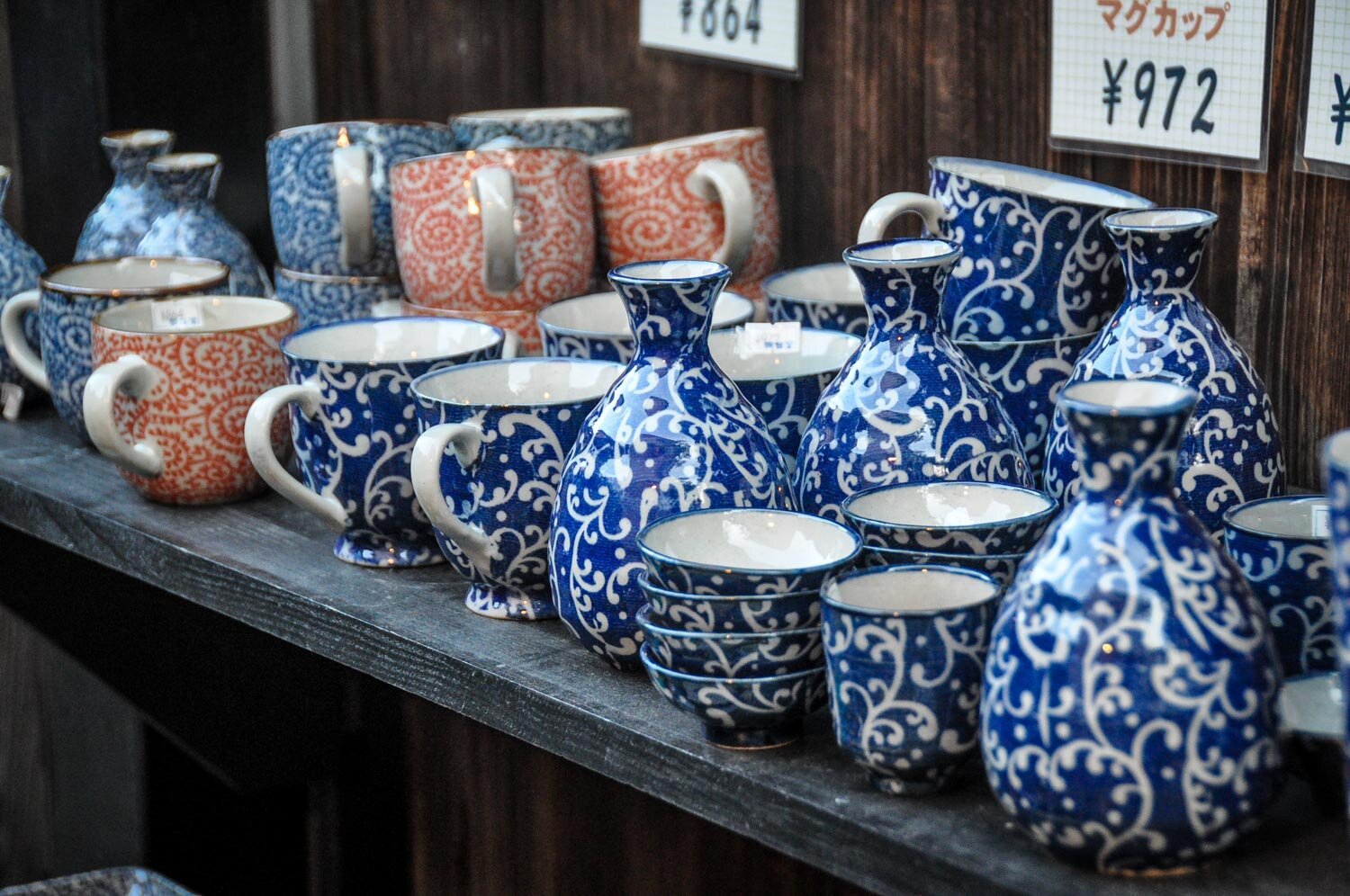
We love bringing back mementos from our travels to remind us of the places we’ve been. If you’re planning a trip to the “Land of the Rising Sun”, we’ve got good news: there is no shortage of things to buy in Japan.
The only problem is trying to figure out how you’ll fit it all into your suitcase!
Over the years, we’ve gotten more and more picky about the souvenirs we bring back. We want to fill our home with beautiful pieces of art, souvenirs that serve a purpose, and mementos that have a special meaning instead of just adding unnecessary clutter to our house.
In this guide, we’re sharing our favorite Japanese souvenirs that go beyond cheap trinkets (though we do make a few exceptions for Daiso and Don Quijote finds!).
1. Ceramic bowls
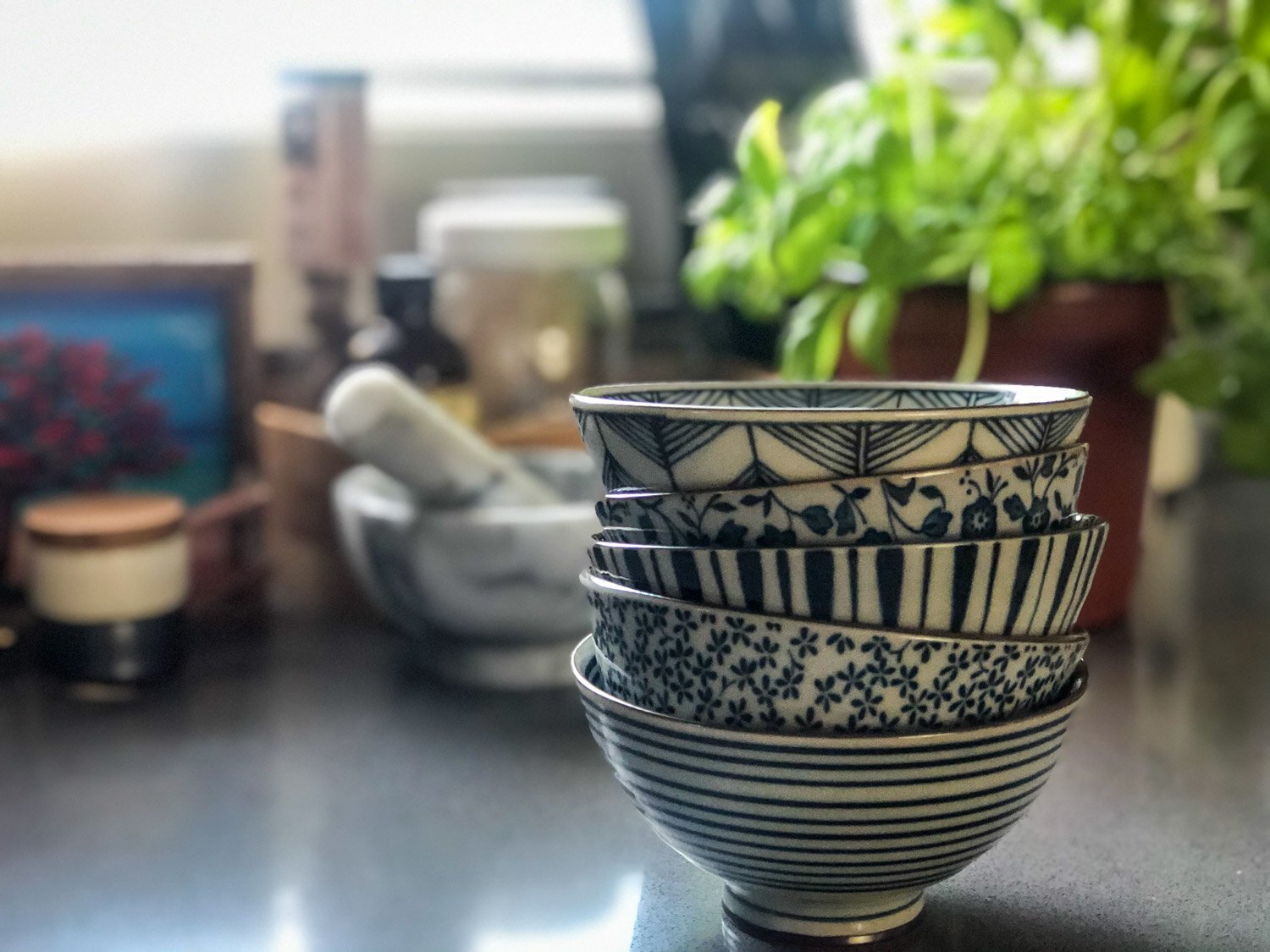
Ceramics are the perfect souvenir from Japan because not only are they beautiful works of art, but very practical for everyday use. We bought a set of small ceramic bowls from a tiny boutique in Tokyo. Choose from all shapes, sizes and styles to fit your taste.
Now every time I eat ice cream out of our bowls (which is more often than I would like to admit), I’m transported to that tiny shop and begin to reminisce about our time in Japan.
2. Chopsticks
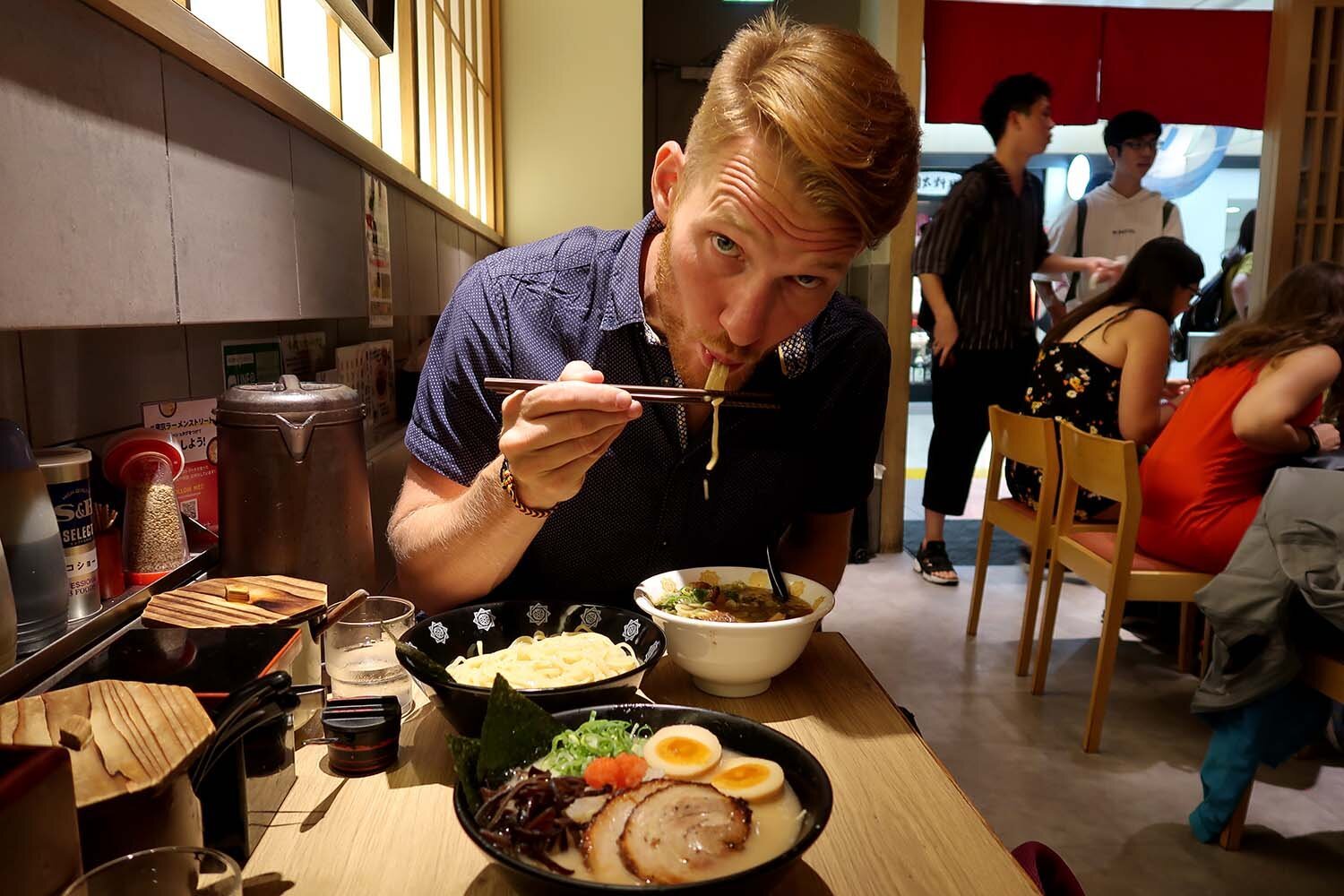
If you like to cook Asian cuisine at home, picking up some chopsticks in Japan is a great idea!
You’ll have lots of different options and designs to choose from. Also, think about how many sets you’d like to get. Do you often host dinner parties or do you have a big family? Maybe getting a 6-pack or an 8-pack of chopsticks is a good idea. Or perhaps you just want a set for yourself. You can select your favorite colors or patterns and even have it engraved with your name.
We have whole article on foods to try in Japan, and let me tell you, there is so much more than ramen and sushi. Speaking of sushi…
3. Goshuin book
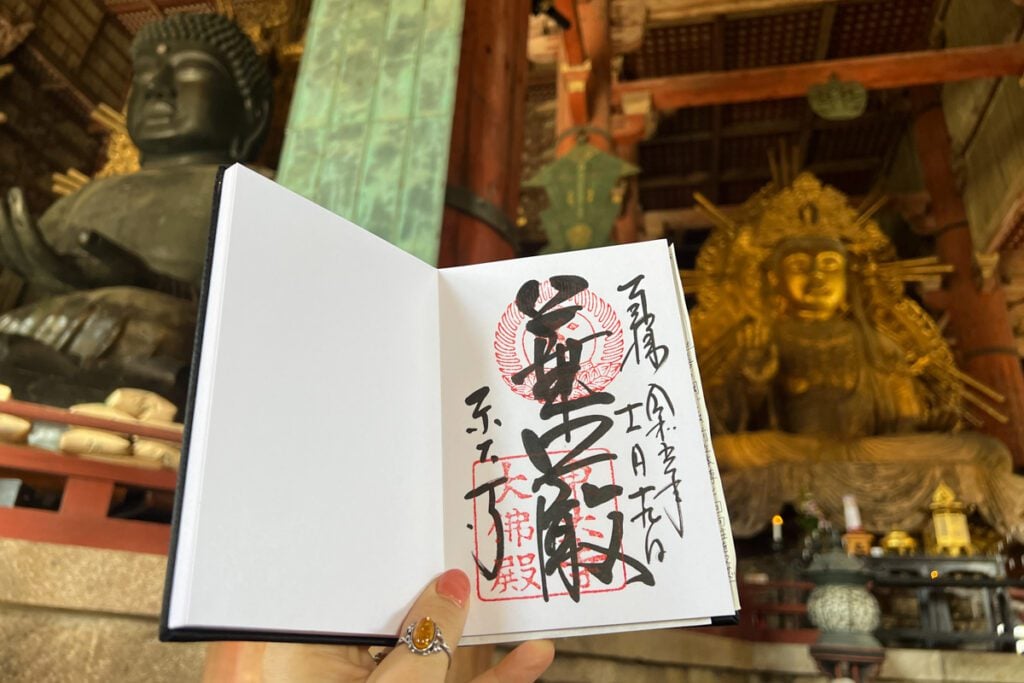
One of the most interesting and unique Japanese souvenirs you can get is to collect Goshuin.
This is a red stamp that can be collected at shrines and temples in Japan. You will use a special book to collect these stamps, called goshuincho, which can be purchased at many temples or shrines.
In ancient times, this was a way to show proof of your visit to the temple or shrine, and it showed your devotion. Today, it is kind of a cool way to remember your trip to Japan and the temples or shrines you visited.
The goshuin seal is meticulously hand-stamped by a temple or shrine staff member using special red ink, while the calligraphy typically includes the name of the temple, date of visit, and sometimes a blessing or prayer.
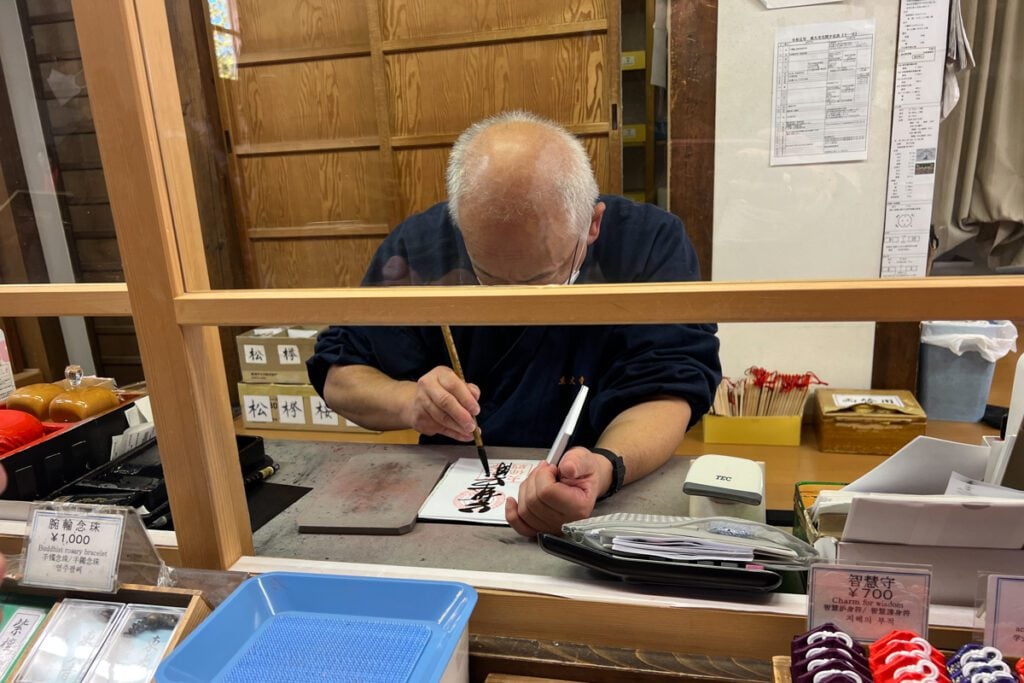
To collect a goshuin, simply visit a temple or shrine in Japan and approach the designated goshuin office or desk. Present your goshuincho to the attendant, along with a small donation (usually around 300-500 yen) as a token of appreciation. (There is typically a price already set.)
The attendant will then apply the goshuin seal and calligraphy inscription to your book using traditional techniques. Each goshuin is unique to the temple or shrine you visit, making it a personalized memento of your journey and beautiful keepsake to treasure for years to come.
Insider tip: Take a photo with your goshuin in front of the temple or shrine so you don’t forget where it came from. They can easily blend together if you aren’t fluent.
4. Tsuko-tegata
Similar to a Goshuin book, a Tsuko-tegata is a traditional hand-carved wooden stamp used in Japan to commemorate visits to sumo wrestling events. This unique Japanese souvenir adds a cultural touch to your sumo experience.
The Tsuko-tegata typically features intricate carvings related to sumo, such as wrestlers, symbols, or the event’s name.
To buy a Tsuko-tegata, attend a sumo tournament in Japan and visit the designated souvenir area within the venue. Look for the Tsuko-tegata counter, where skilled craftsmen will use the wooden stamp to create a personalized imprint on your sumo stamp board or a piece of paper.
5. Ema
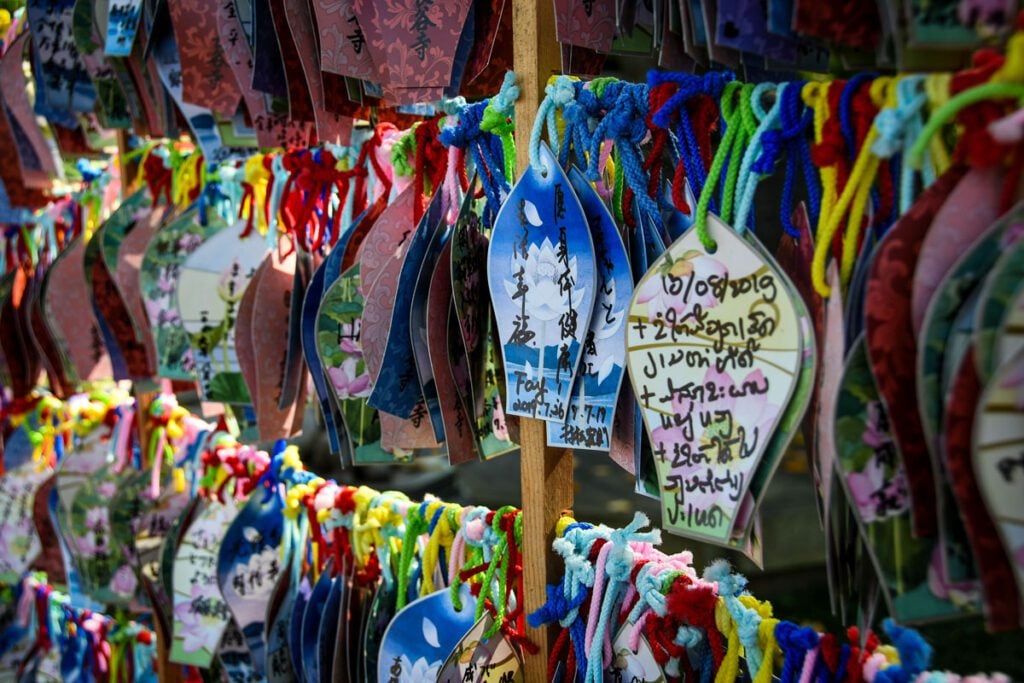
Ema are wooden plaques in Japan traditionally used for writing wishes or prayers, often found at Shinto shrines.
To collect an ema, visitors typically purchase one from a designated area near the shrine, choosing from a variety of shapes and designs. After obtaining the ema, they write their wishes or prayers on one side and then hang it on a dedicated display board at the shrine.
Ema serve as a tangible expression of hopes and dreams, and the act of hanging them is believed to convey these wishes to the kami, the Shinto spirits, for consideration and fulfillment.
6. Sushi magnet
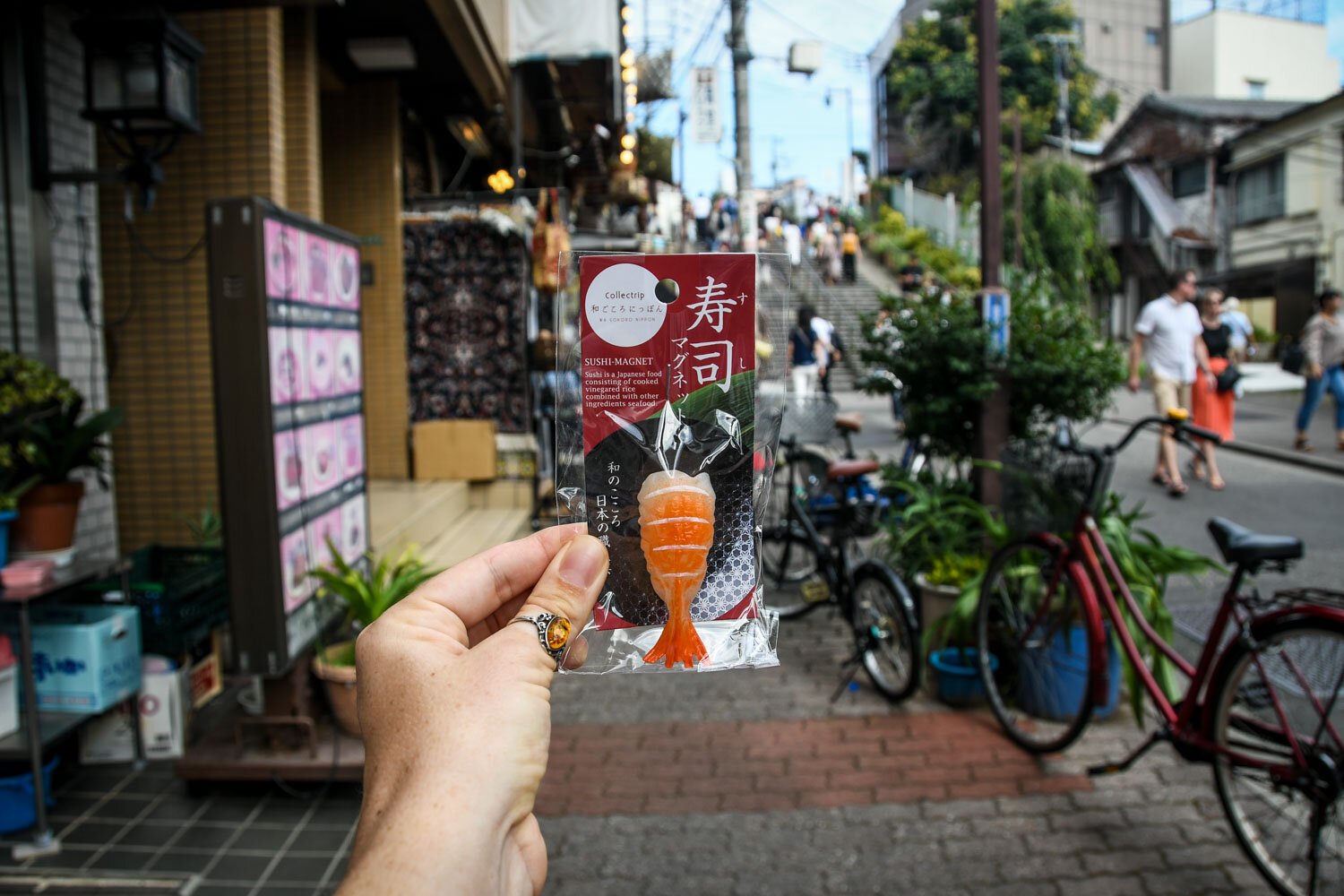
Ahh, the classic sushi magnet. This is a cheap and somewhat useful Japan souvenir you can pick up at just about any discount store, like Daiso or Don Quiote. I told you there’s be exceptions to our no dollar store rule!
We bought one of these as a gift for my brother who has an affinity for all things weird, and also for shrimp. Spoiler alert: He loved it.
7. Pens and stationary
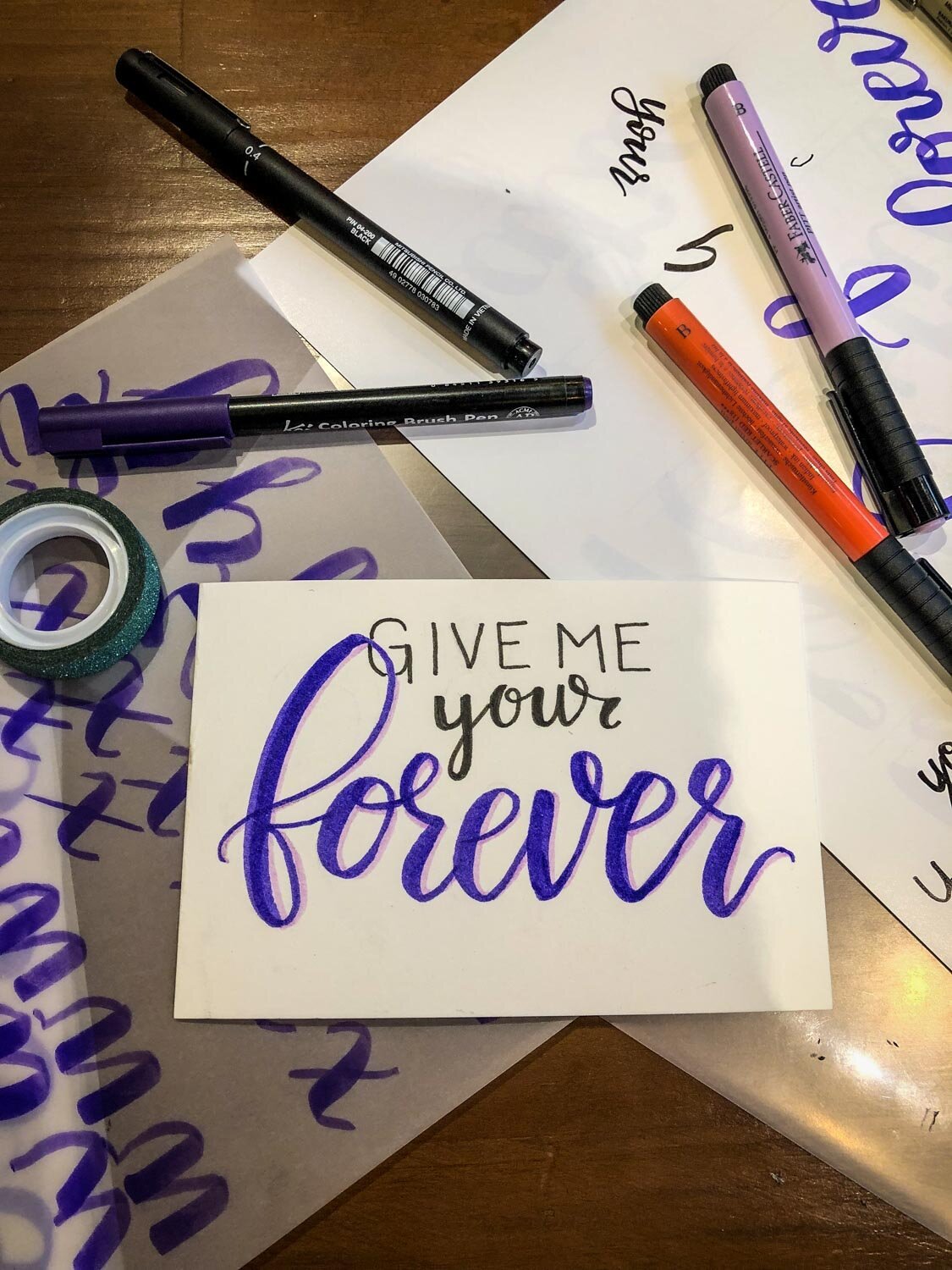
If you’re into brush lettering, or heck just want some fancy pens, this is a fun and useful thing to bring home.
Japan is known for very high quality brands of pens and paper. Some of the best being:
- Koi Brush Pens
- Tombow Brush Pens
8. Calligraphy set
If you want to take your lettering a step further, you can pick up a traditional calligraphy set while in Japan.
Don’t know how to use them? Why not book an Airbnb Experience where a local can teach you the art of calligraphy! Or if you don’t have time on your trip, sign up for a class on Skill Share (get 2 months free!), or teach yourself through YouTube videos.
→ Read next: We’ve rounded up all the things Japan is most famous for in a guide that’s also packed with practical travel tips. Plus, we’re sharing a few things we personally think Japan should be famous for, but most foreign tourists are surprised to know.
9. Japanese Fan
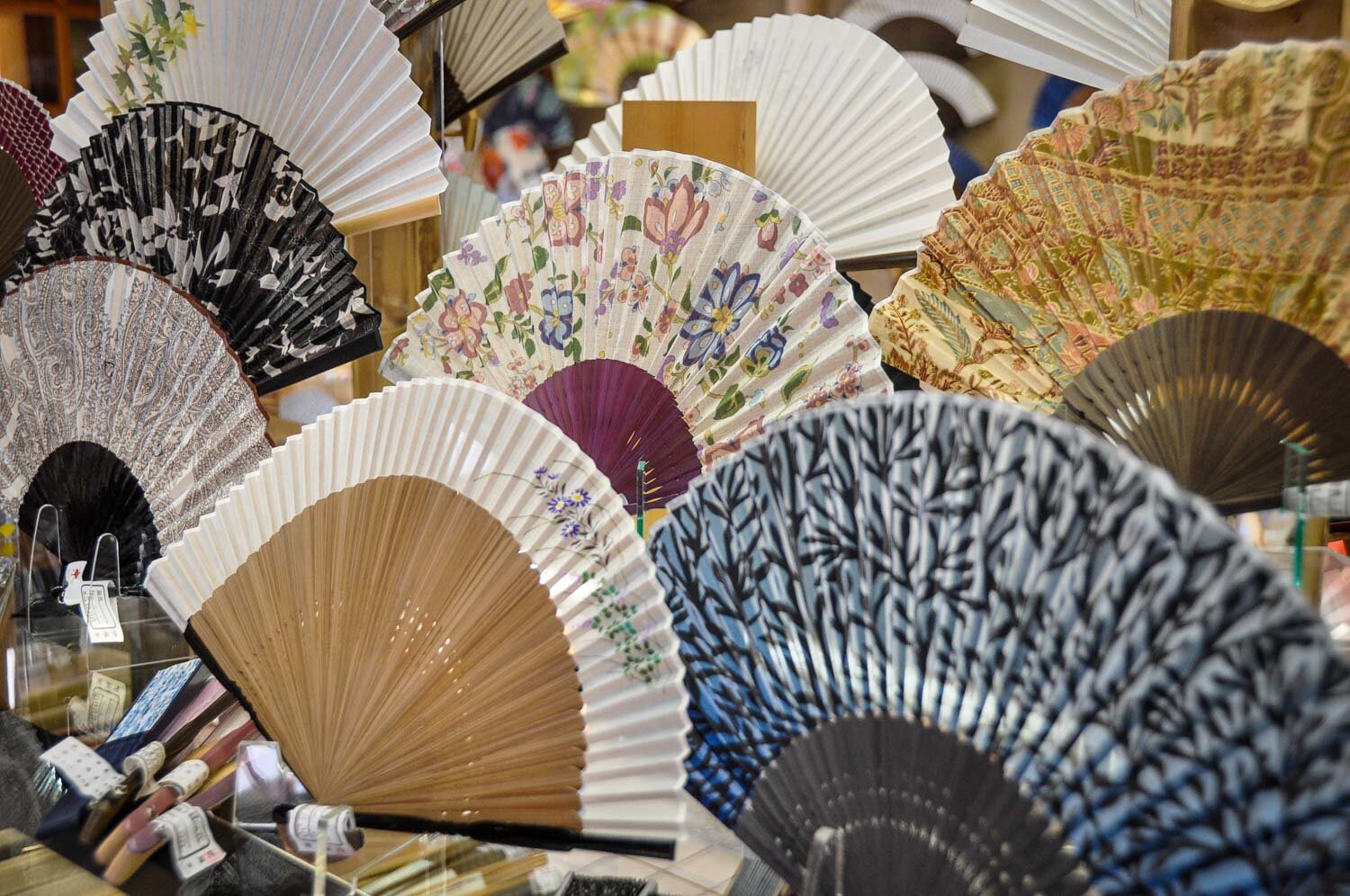
Getting a beautiful hand-painted fan was on my must-buy list during our first trip to Japan. And I was spoiled for choice!
In fact, I wouldn’t have even needed to buy one because our Airbnb host left a small package for us, inside of which was a fan. How sweet! And if you’re traveling to Japan during the summertime, you’ll likely be handed some sort of cheap variety of fan on the street (perhaps with an advertisement or logo on it).
However, it’s good to know that the quality of fans varies quite a bit. If you go to a super touristy street you’ll see fans for sale by the basket. And they’re quite cheap! However, it’s good to know that these are often mass-produced in China, and aren’t true Japanese fans.
If you’re looking for the real deal, there are many shops dedicated solely to fans, and the store owners can tell you more about each one. They often have many different price points so you can find one to suit your taste and budget.
I believe we paid around $25 USD for our fan, so it was certainly not the highest quality, but it was just what we were looking for and how much we were willing to spend.
10. Artwork
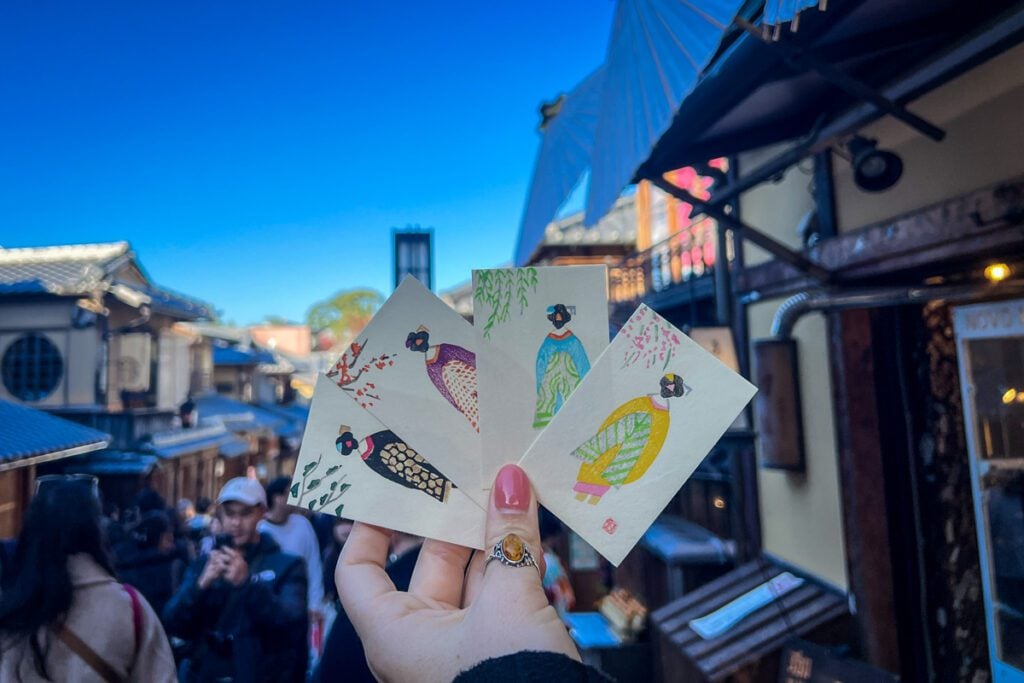
When in doubt, you can’t go wrong with buying a piece of artwork as a souvenir. We love purchasing small prints on our travels because they are one of the easiest things to fit in our luggage to bring home with us.
You can find all kinds of artwork and prints in Japan in small boutiques and markets.
Perhaps one of the most iconic Japanese pieces of art is “The Great Wave Off Kanagawa”. It is beautiful and different versions of this are sold all around the country. And if that design just isn’t you, don’t worry — there are plenty of other gorgeous Japanese works of art to choose from.
11. Fabric
I have a thing to collecting fabric from around the world. I’m not sure quite what I’ll do with it all, but I’m plotting some ideas…
Japan has a variety of beautiful textiles, and we bought a yard of a pattern that caught my eye. Now the question is what should I do with it? Make a pillow, a quilt, coasters, a wall hanging…
12. Charm (Omamori)
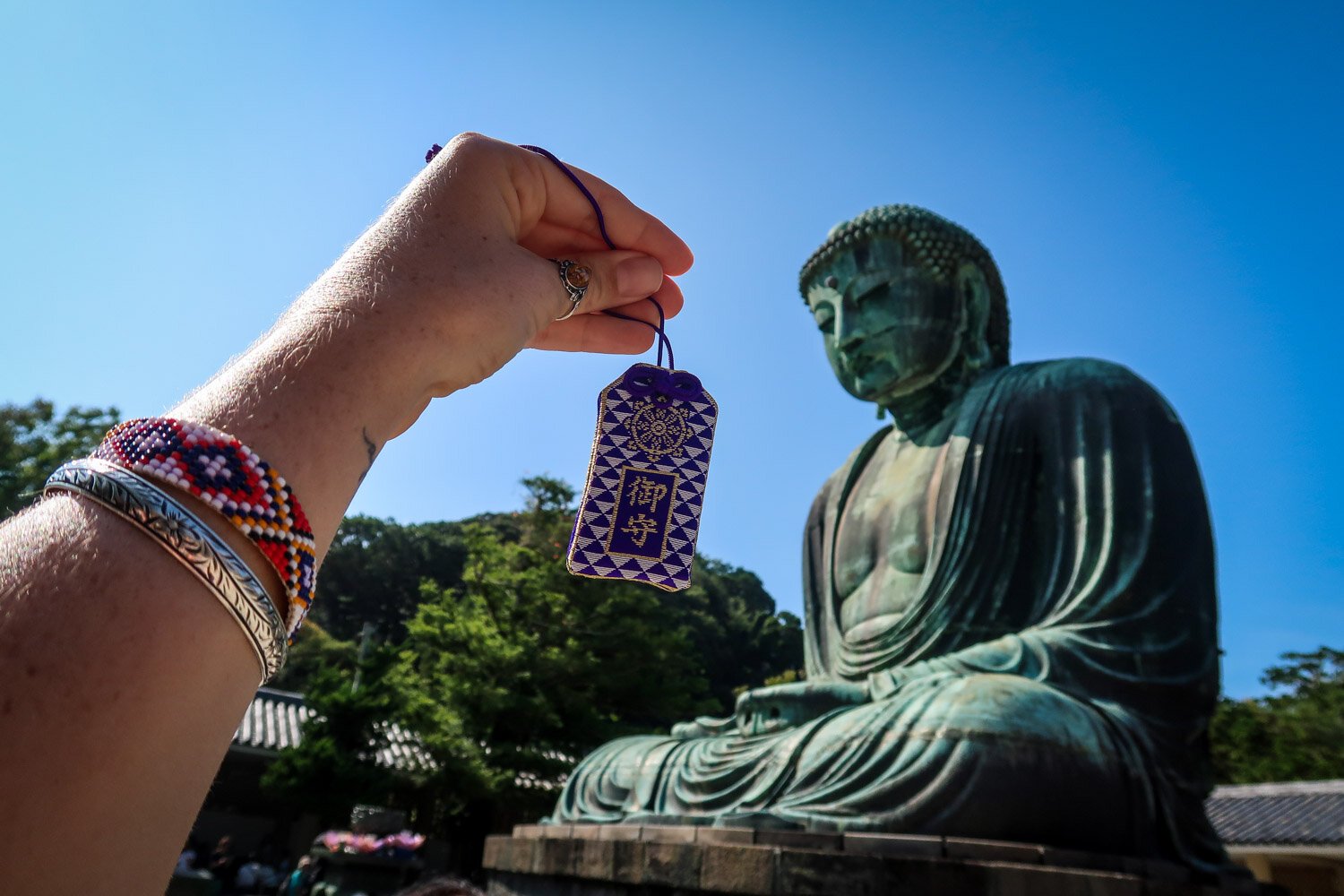
You can find these charms at just about every large shrine or temple, and they make a meaningful and inexpensive memento.
We chose one that means “protection against calamities” and hung it on the review mirror of our car. Hopefully it does what it says!
13. Daruma
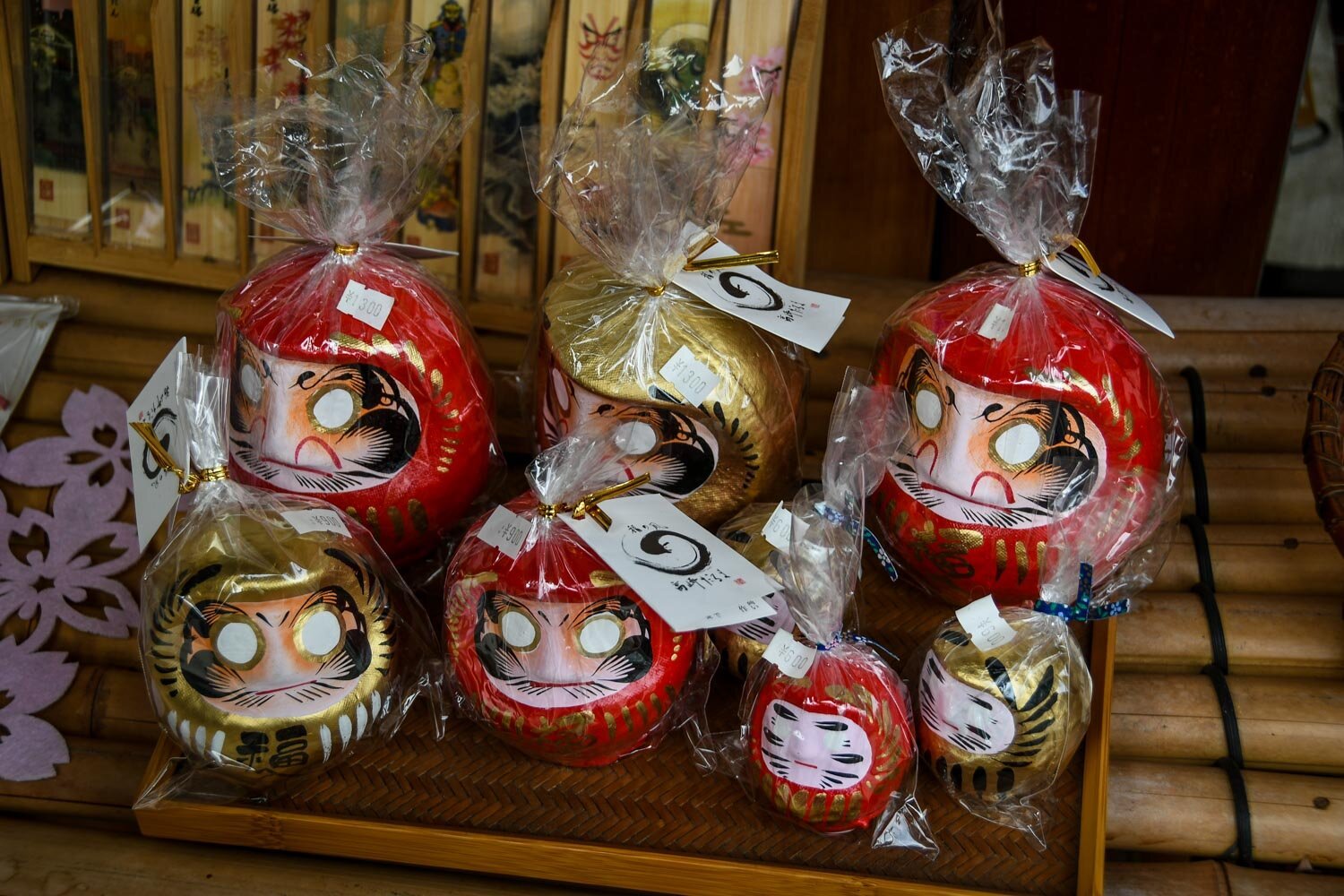
This is one of our favorites, and we actually bought one of these guys on our most recent trip to Japan.
These figurines come in all different sizes, so you can choose one based on how much space is left in your suitcase!
The Daruma Doll has blank eyes. When you bring him home, you are supposed to set an intention or goal and color in one of the eyes. The other eye should be left blank until you complete this goal. That blank eye is a constant reminder of your intention, and trust me when I say it really motivates you to make those dreams happen!
14. Waving kitty (Maneki Neko)
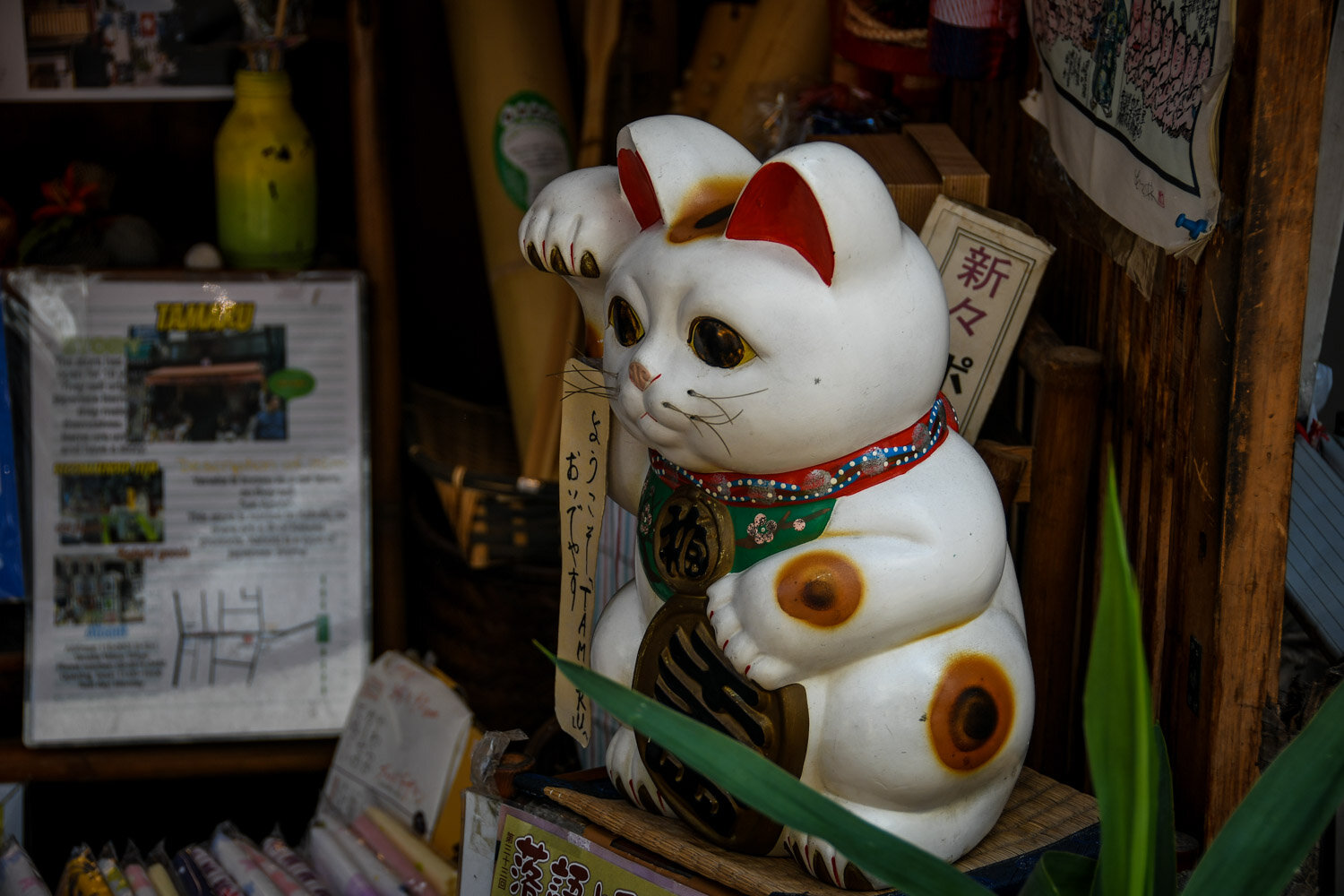
You know those cats with the waving arms that are ubiquitous to Asian restaurants? Well, you can find them everywhere in Japan and they have a pretty cool meaning, making them a great souvenir option.
Those kitties have a name: Maneki-neko, or “beckoning cat”
And they are said to bring good fortune to their owner. I think we all could use some good fortune, so go ahead and buy a few maneki-neko on your travels to give as gifts when you return home. And no, buying more than one does NOT make you a crazy cat lady (or man).
15. Origami
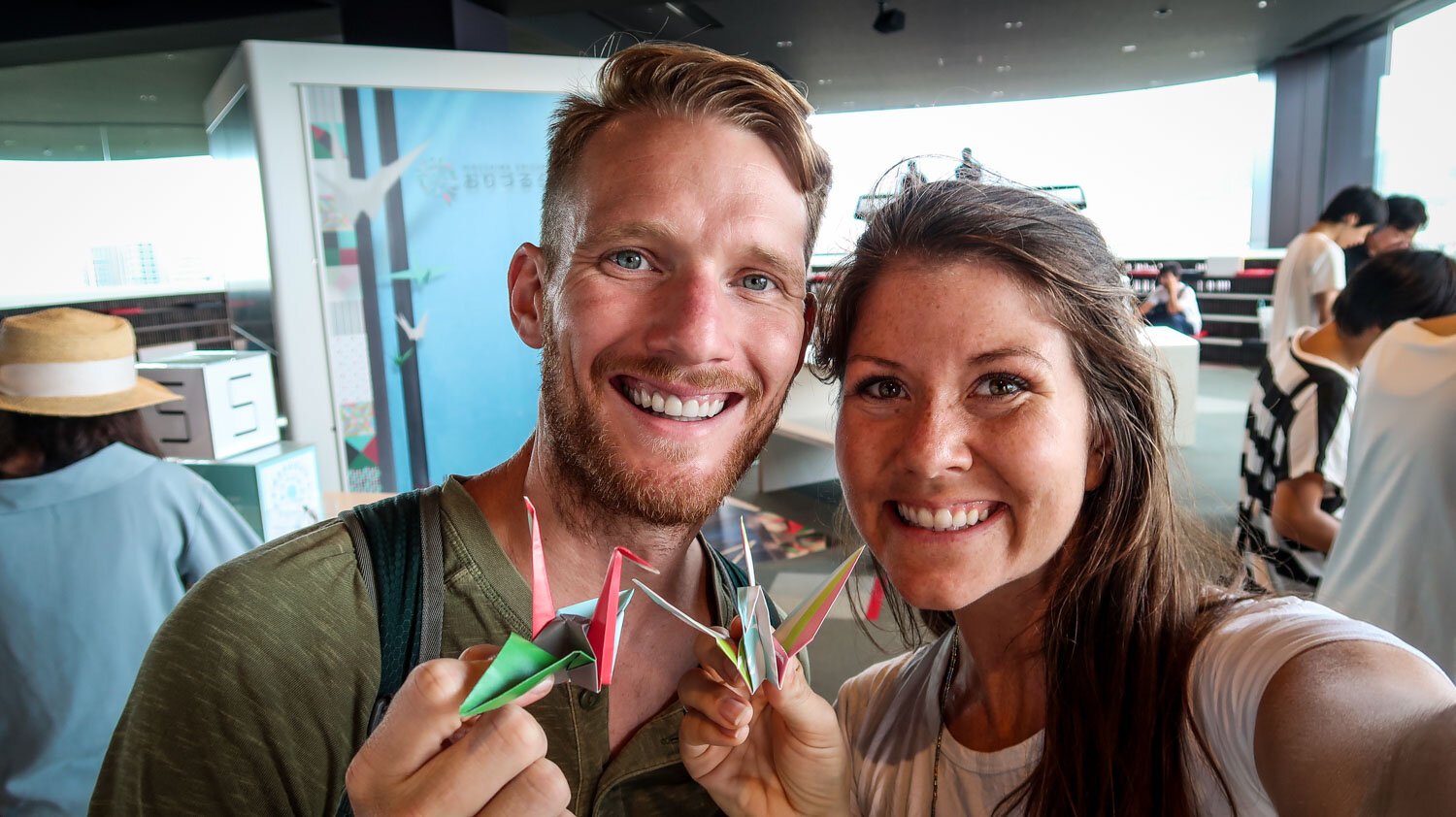
The paper folding art dates back to the Edo Period in Japan. From paper cranes to boxes to tigers, there is really no limit to what you can make out of origami.
If you are traveling to Hiroshima, it’s worth a visit to the Orizuru Tower. The word orizuru means “paper crane” and on the 12th floor of this tower, there is an interactive exhibit where you can make your own origami crane.
Once you purchase the paper, the staff helps you make the paper crane which you can take home as a souvenir from Japan. Or you can make a wish and let your paper crane fly down the 12-story Orizuru Wall. This massive display contains thousands of paper cranes and can be seen from the street outside the tower.
Orizuru Tower also has a viewing platform on its top floor where you can see all of Hiroshima from up above.
Adult entrance: 1,700 Yen ($15.50 USD)
16. Yen coins
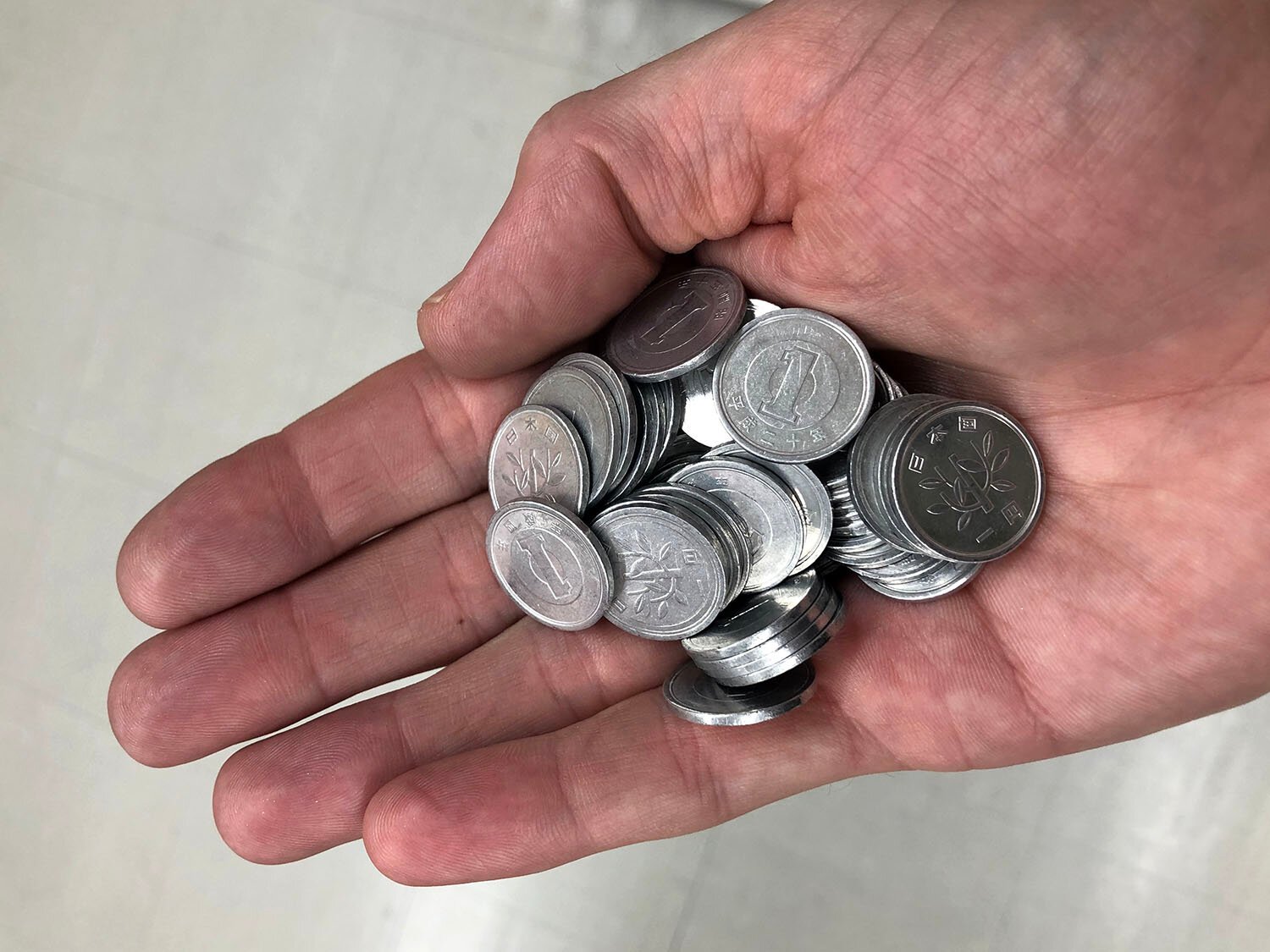
We like collecting a few coins from each country we visit. It’s a simple and cheap Japanese souvenir that we don’t need to make an effort to seek out. Yen coins are pretty cool looking too, especially the ¥5 and ¥50 yen coins, which have a hole through the middle.
17. Maps

We both have a map fetish, so it comes as no surprise that this is another souvenir we like to collect on our travels around the world. Sometimes the free city maps are pretty cool, and we stash them in our luggage instead of tossing them in the trash. Other times, we purchase larger maps of the area.
Tip: There are tons of crafts you can do with maps you collect, like this DIY map coaster project that we’ve been wanting to do for years!
18. Purikura
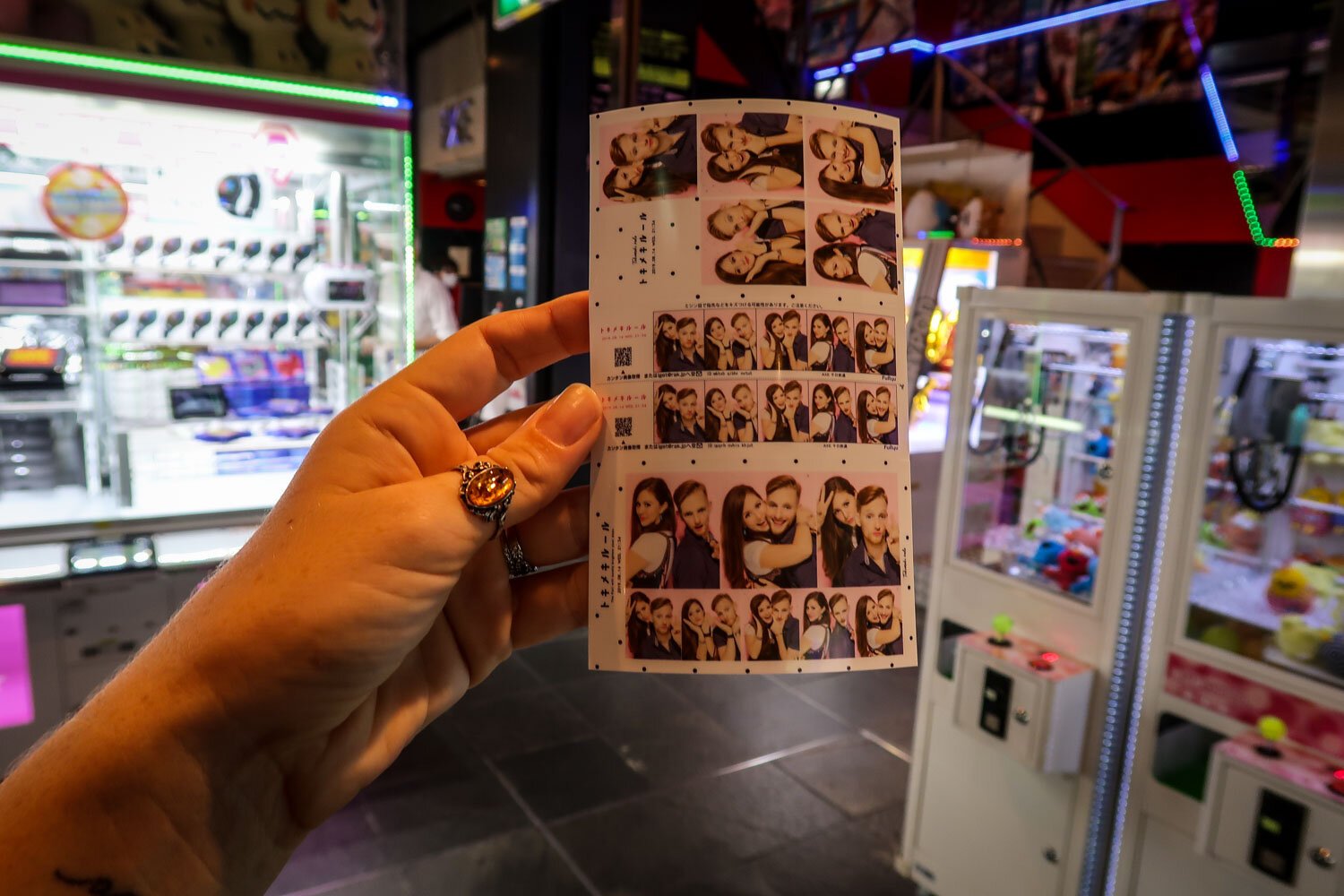
This cheap Japanese souvenir doubles as a fun experience you can only have in Japan!
Purikura are unlike any photobooth you’ve ever tried. You won’t simply snap a few poses and have your pictures printed out… Instead, you’ll get to alter the images by adding virtual stickers, makeup, and backgrounds, leaving you with one hell of a souvenir from your trip to Japan!
The one we visited in Osaka was 400 yen.
19. Japanese spice mix
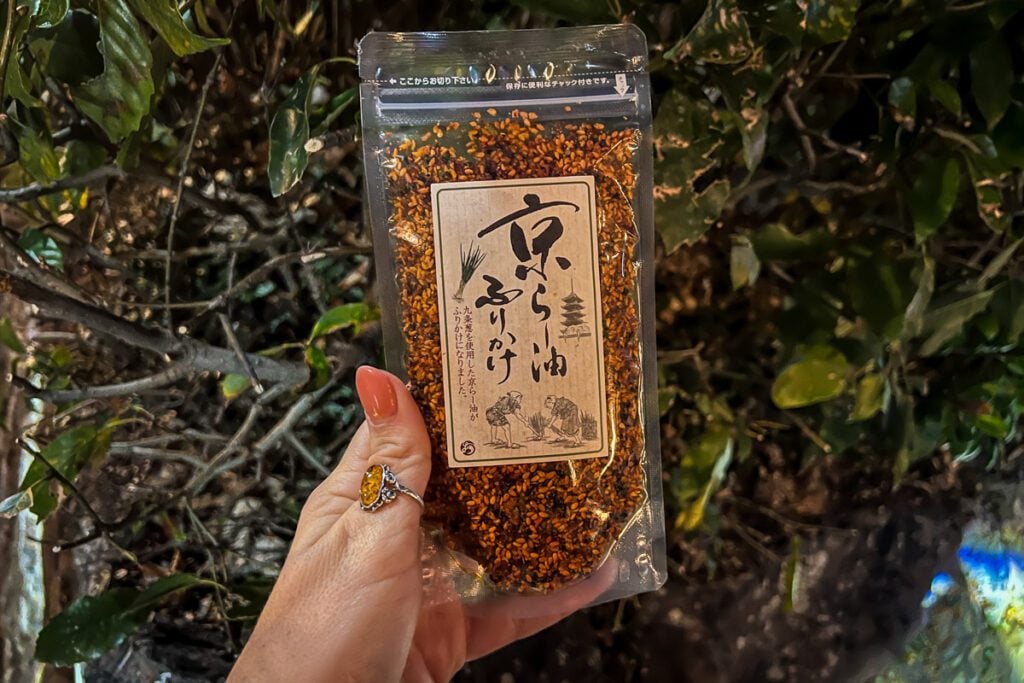
Japanese spice mixes are flavorful blends that add a kick to various dishes. Typical ingredients in spice mixes include red chili pepper, ground sansho (Japanese pepper), black and/or white sesame seeds, hemp seeds, roasted orange peel, ground ginger, and nori (seaweed).
You can find Japanese spice mixes in local markets, supermarkets, or in specialty spice shops in Japan. Look for beautifully packaged Shichimi Togarashi (a general Japanese seven spice blend) or other regional spice mixes that reflect the unique flavors of the area you’re visiting.
We bought our “Kyoto-style chili oil flavor seasoning” which was a combination of Ichimi and Shichimi mix at a market in Kyoto. You can also find it in this market in Arashiyama. They have samples in store so you can try it before you decide to purchase.
20. Japanese Sweets
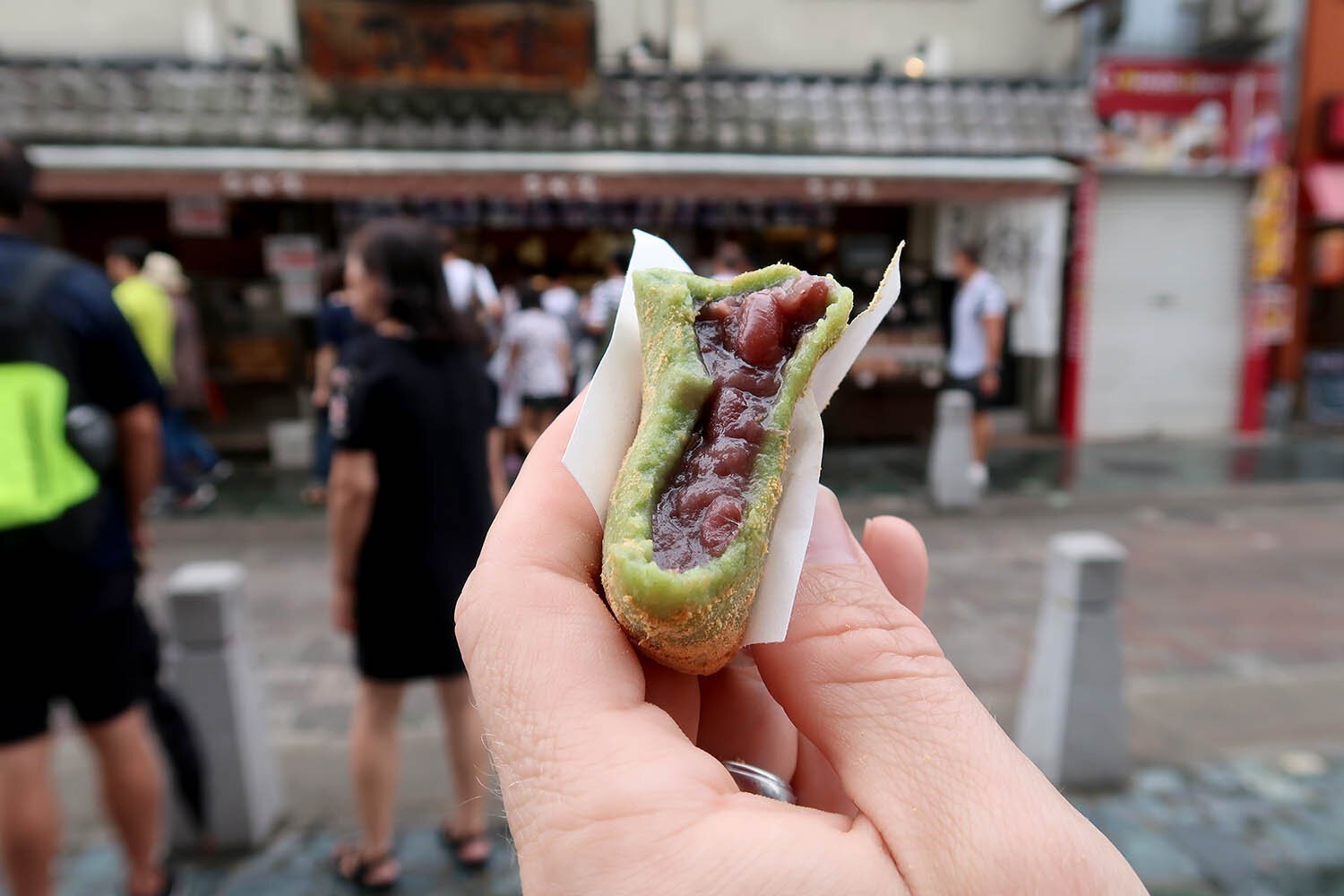
Choose from traditional Japanese sweets like manju or daifuku that are sold insouvenir shops in malls or train stations. Manju is a Japanese rice cake that is filled with many different flavors but the most common is red bean. These are typically prepackaged and convenient for bringing home.
Another big thing to take home is (surprisingly) Kit Kats. The word Kit Kat is similar to the Japanese word for “good luck” so a few years ago the candy bar was a viral sensation and created loads of new flavors. In fact, since 2000, over 200 flavors have been released.
There are some flavors you would expect like matcha (green tea), salt and caramel, and cinnamon. But some that are quite unique like edamame, fruit parfait, and soy sauce (the most popular flavor in 2010).
We didn’t really hop on the Kit Kat train, but we definitely indulged in the sweet aisle while browsing convenient stores. We had a short-term love affair the Sugar Butter Sand Tree crispy cookies. I dare you to just eat one…
21. Sake or Whiskey
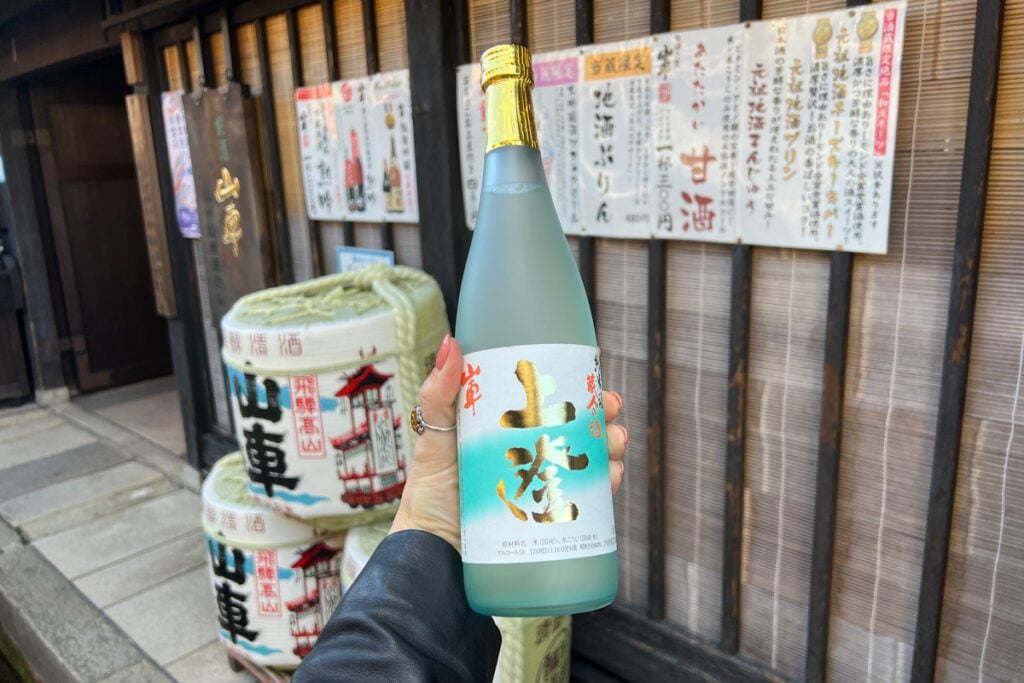
If you’re a fan of sake or Japanese whiskey, why not bring some of the good stuff home with you?! This would be a fun way to share a taste of Japan with family and friends back home (or just stash it all for yourself, no shame in that!)
Before you pack your checked bags with bottles, make sure you know the customs laws of your home country.
Tip: The sake bottles make great flower vases once they are emptied!
22. Japanese Recipes
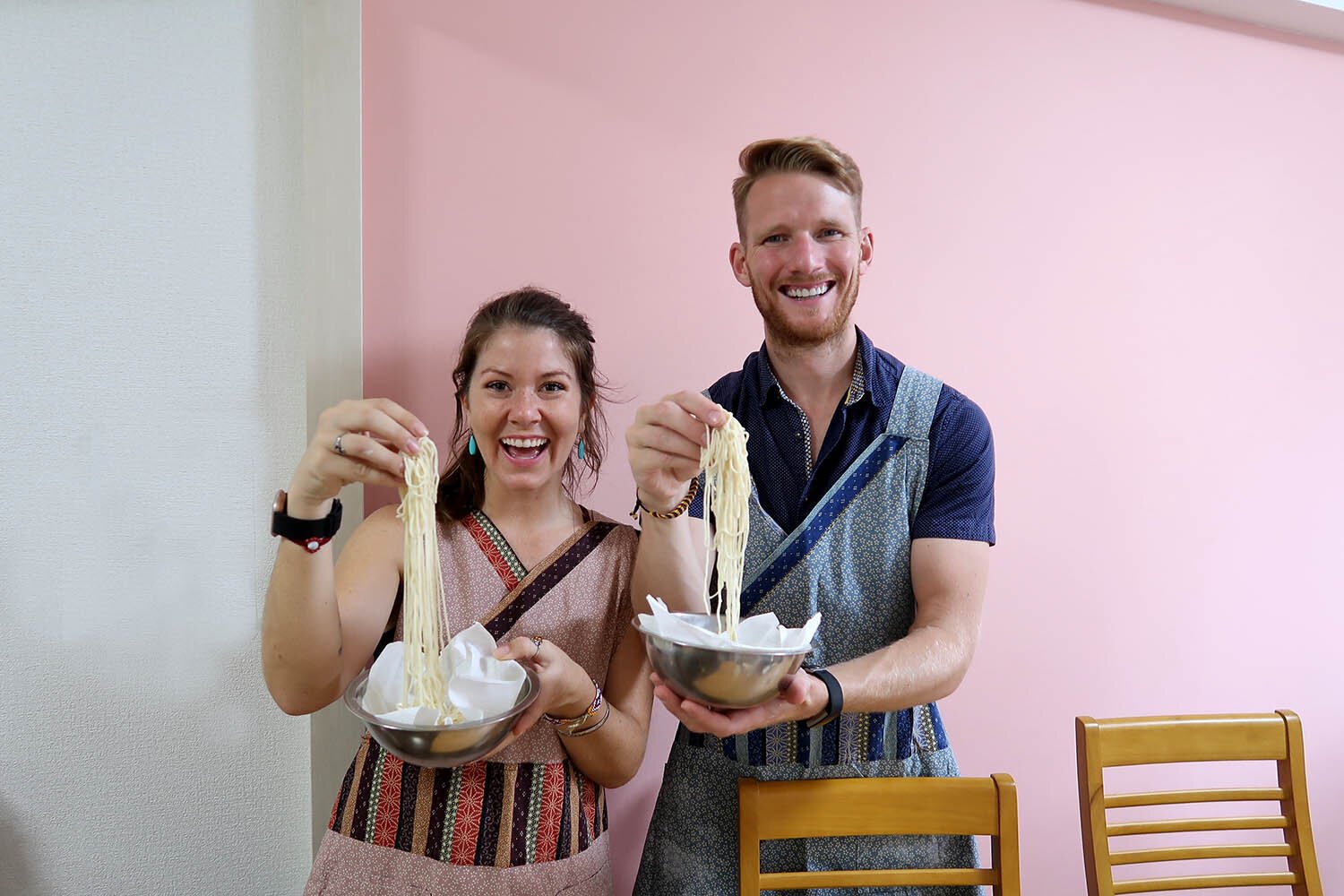
This souvenir is a bit more abstract, but bear with me…
We are obsessed with taking cooking classes on our travels around the world. Not only do we get to have an incredible meal, but we get to spend time with a local and get a deeper glimpse into the culture. After every cooking class we’ve taken (and we’ve taken lots!) we have been gifted with a recipe card or book to bring home with us. This is truly the souvenir that keeps on giving because we can now recreate this meal at home.
While traveling in Japan, we took a sushi-making class and a ramen-making class, both of which were fun!
23. Matcha tea
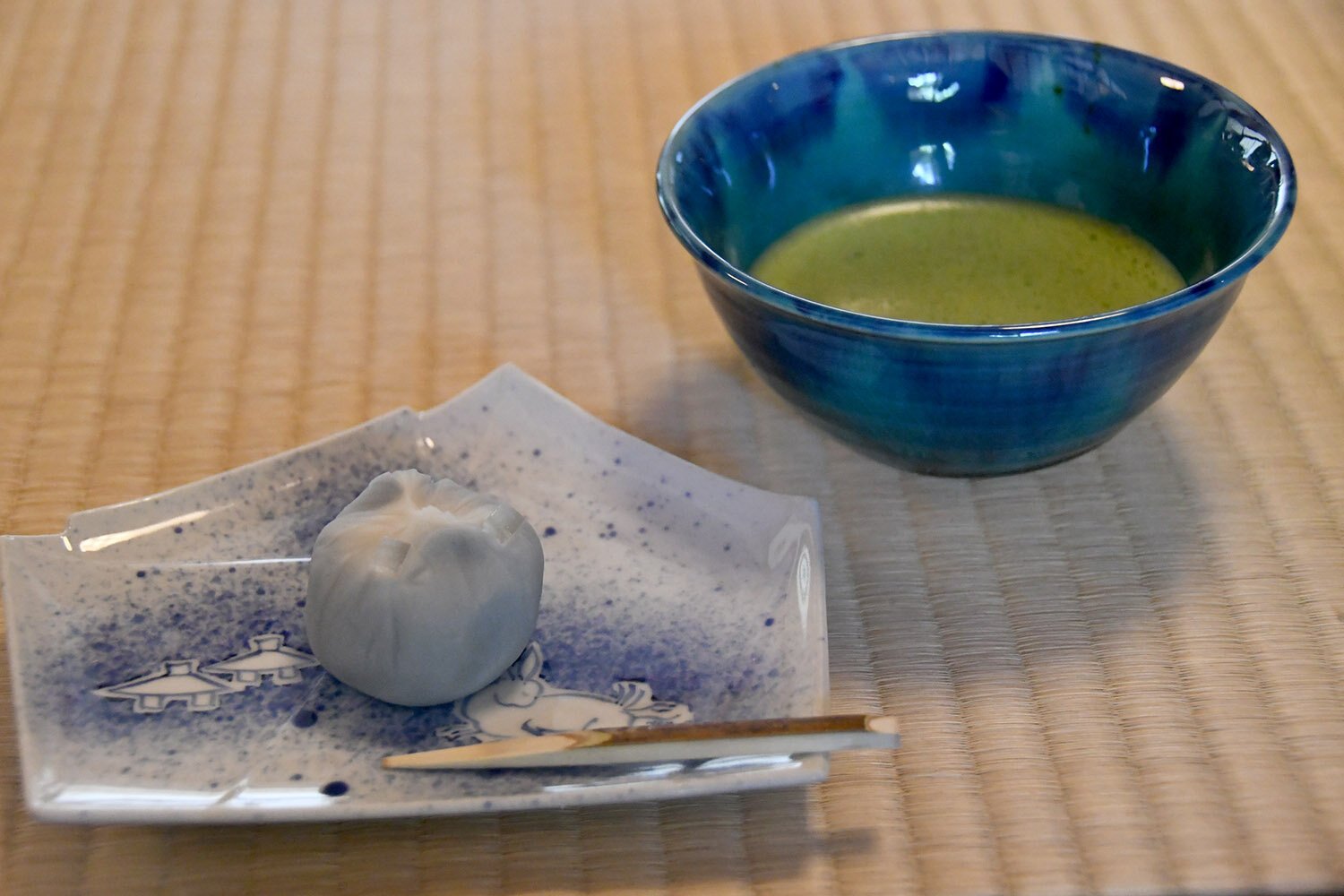
If you’re one for edible souvenirs, bringing home some matcha is about as “Japanese” as you can get. This powdered green tea contains many antioxidants and claims to have many health benefits.
Plus, it packs up well and makes great gifts for friends and family back home.
To learn about the history of matcha tea and how to properly brew it, there are many tea ceremony tours you can take throughout Japan.
24. Knives
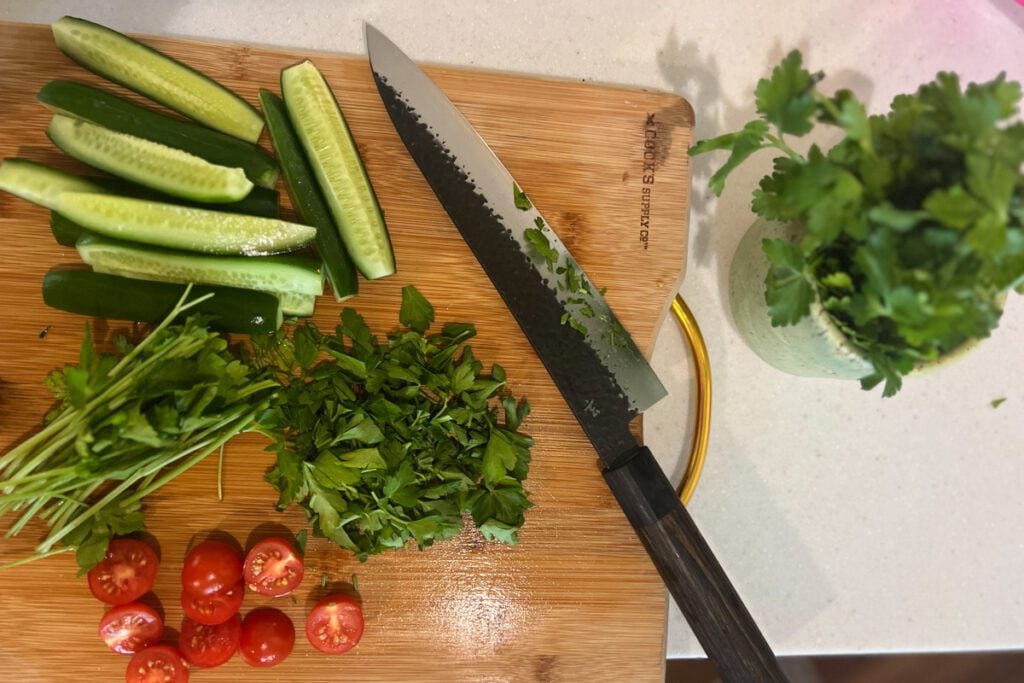
Japan is known for super high quality knives. I mean, those sushi chefs need to have the top-of-the-line knives, so you know you’ll find some Japanese brands. But for the really good knives, expect to pay handsomely.
There are knife shops where everything is made in house, as well as entire streets where you’ll find variety to choose from.
25. Yukata or Kimono
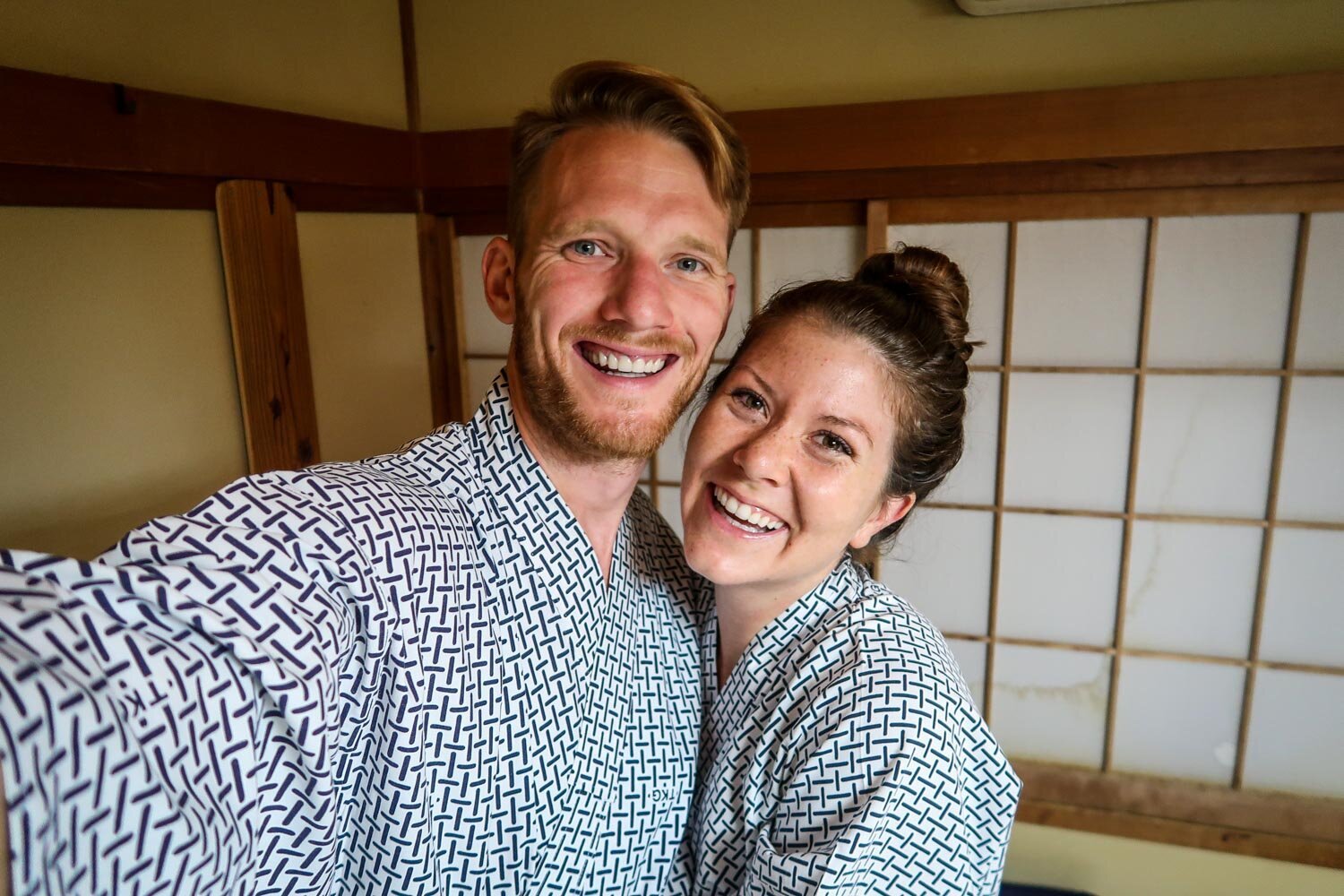
If you have an affinity for Japanese culture, a kimono or yukata might make a great souvenir.
What’s the difference between a yukata and a kimono? Quite a lot actually.
Yukata are typically make out of lighter material such as cotton. They are worn around the home or out during summer months.
Kimono are usually a nice fabric like silk and are traditionally worn as a two collar piece. Kimono is reserved for more formal events like graduations or weddings, however it is common to see Japanese people wearing this traditional attire for work functions too.
A Kimono is more expensive than a yukata because of the quality of material, but you can try one on in most cities if you find a fitter.
26. Face masks
Japanese beauty products are gaining more and more popularity these days. One small item you can fit into your carry on is a Japanese face mask.
These hydrating masks target a variety of skin types and come in all sorts of “flavors” like honey, avocado, collagen, or rice face masks. Perfect for a spa day back home or whenever you want to look like a ghost!
If you forget to grab one of these before you head on your plane, you can always order face masks on Amazon.
27. Japanese Cosmetics
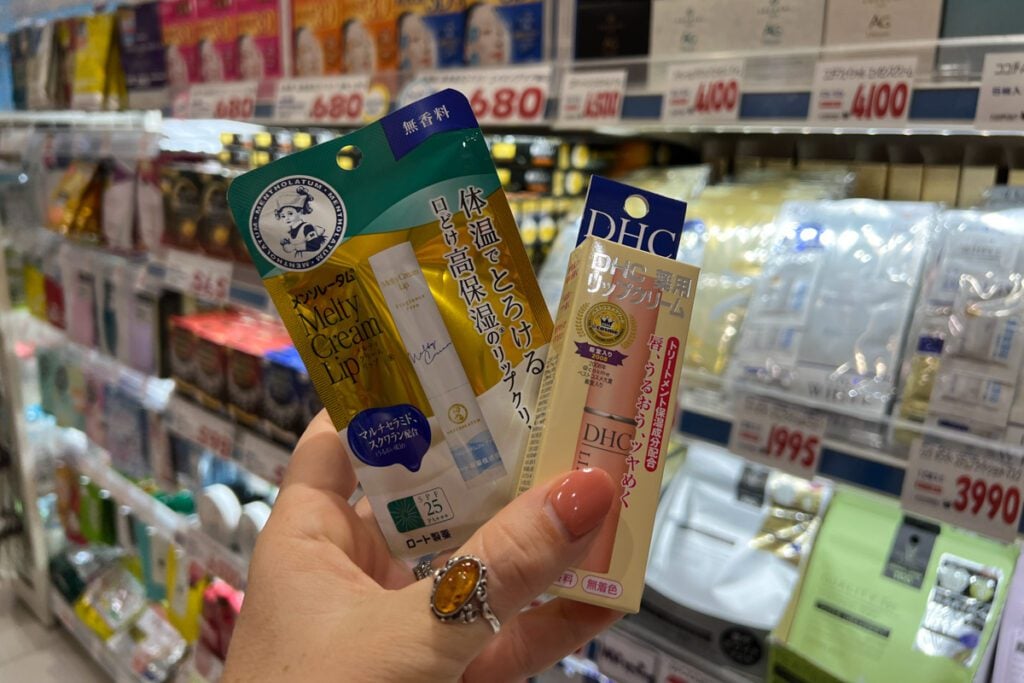
Similar to South Korea, Japan is known around the world for it’s cosmetics. From serums to facemasks to makeup, in recent years Japanese cosmetics have used technology to make innovations in the industry.
There are drug stores and cosmetic boutiques sprinkled in every major city, but the one that stands out to me us is Etude House, which is actually Korean brand. You can find high quality products for a faction of the price back home.
28. Name stamps
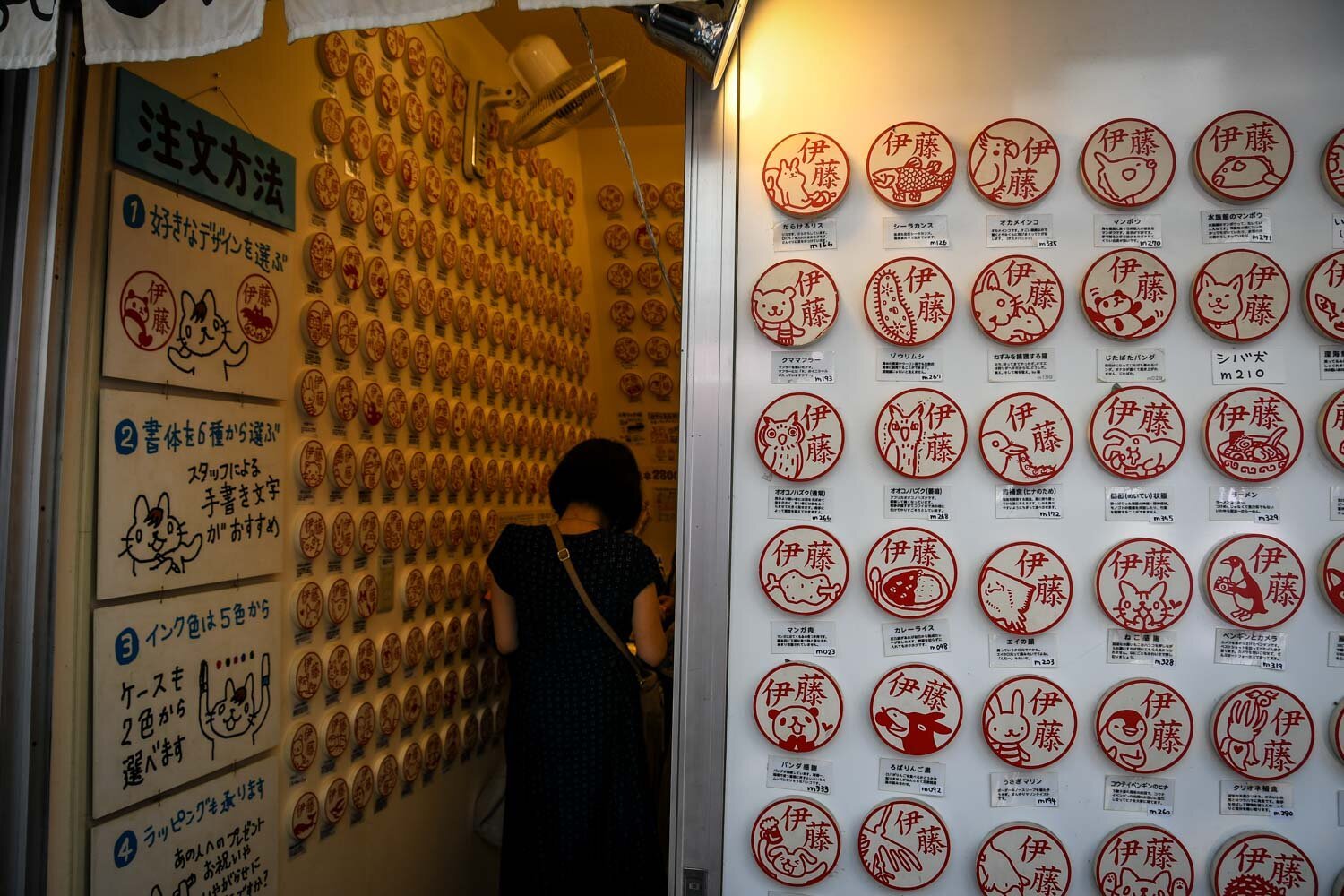
Traditionally used to sign your name on official documents, these name stamps, called Hanko, are quite popular gifts in Japan. In fact, almost every adult in the country has one.
You can go to a shop like the one pictured above and get your name translated into Kanji, the Japanese language. Or you can your favorite cartoon or emoji etched on a stamp for fun. You can find a hankoya (hanko shop) in most neighborhoods.
29. Umbrella or Parasol
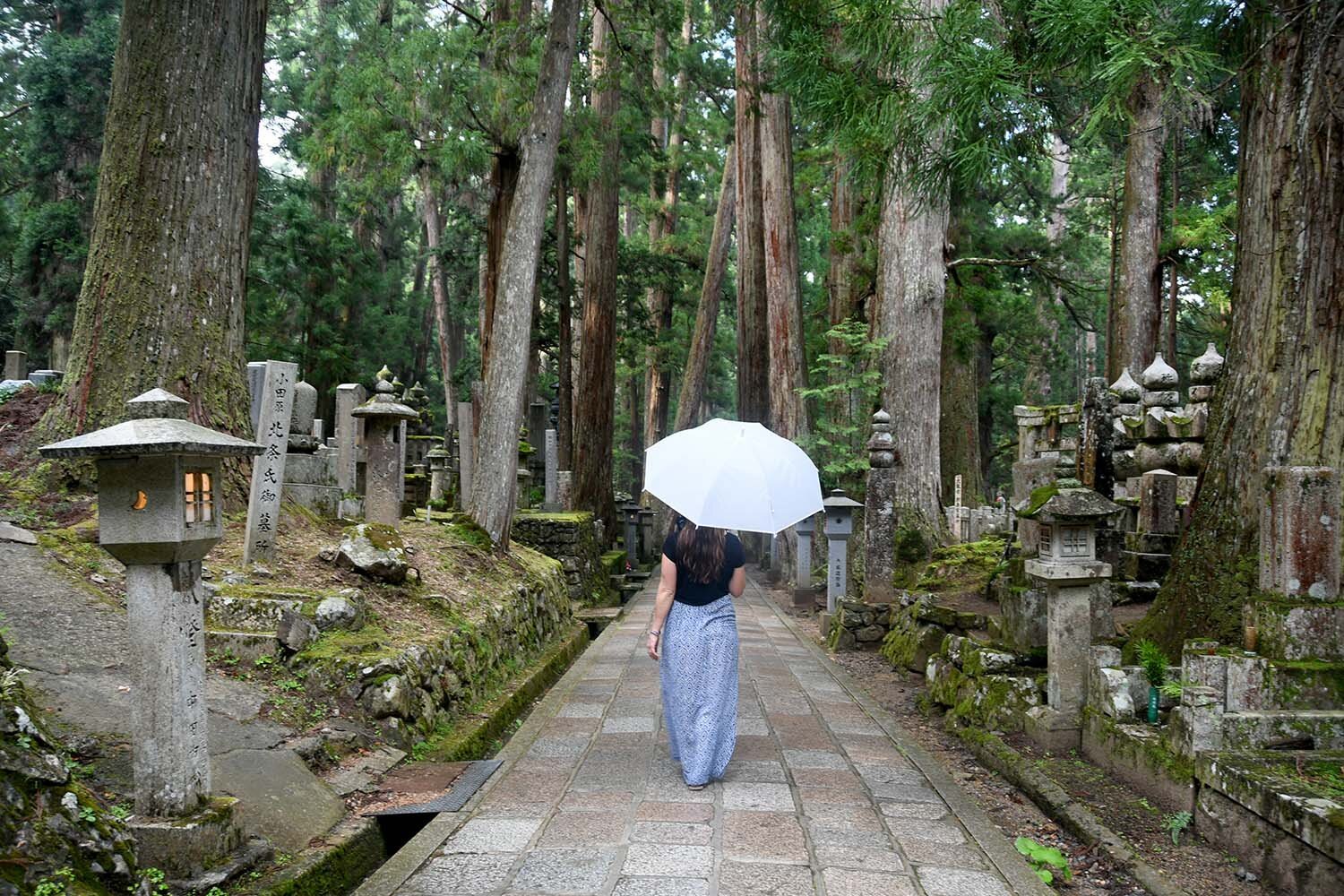
There are few things more iconically Japanese than the parasol, a thin umbrella to provide shade from the sun. They come in all shapes, sizes and colors with countless designs. Most souvenir shops in Japan will have parasols on sale.
While in Japan we purchased an umbrella because it was typhoon season, which came in handy.
Parasols can pack up pretty small and can easily fit in checked luggage for the flight home.
30. Hair Pin (Kanzashi)
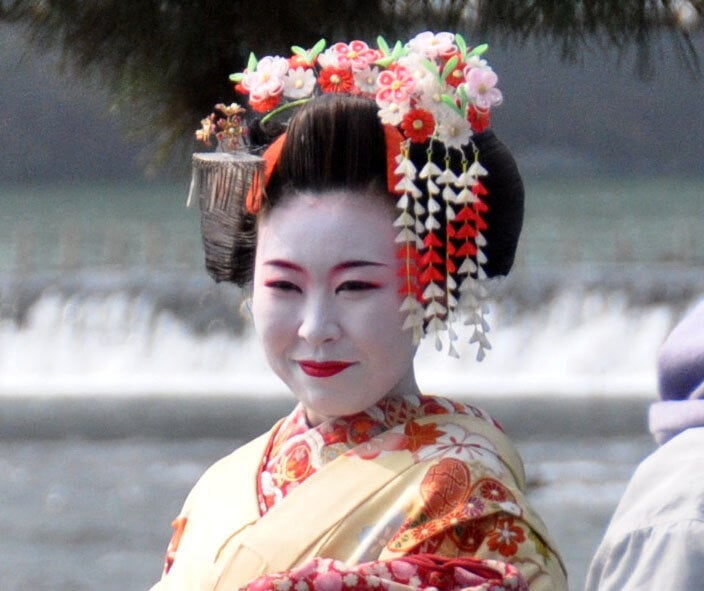
Historically, a kanzashi is traditionally worn in the hair of women during festivals or rituals along with a kimono. These hair pins can be hand-crafted works of art with many designs on the pin as well as the flower ornaments attached to them which can change seasonally.
31. Bento Box
Perhaps the most practical Japanese souvenir you could buy, this is essentially a food container that has separate compartments for small dishes. If you have a kid who brings lunch to school (or you just really like to picnic!), this might make a fun memento.
32. Clothes or socks

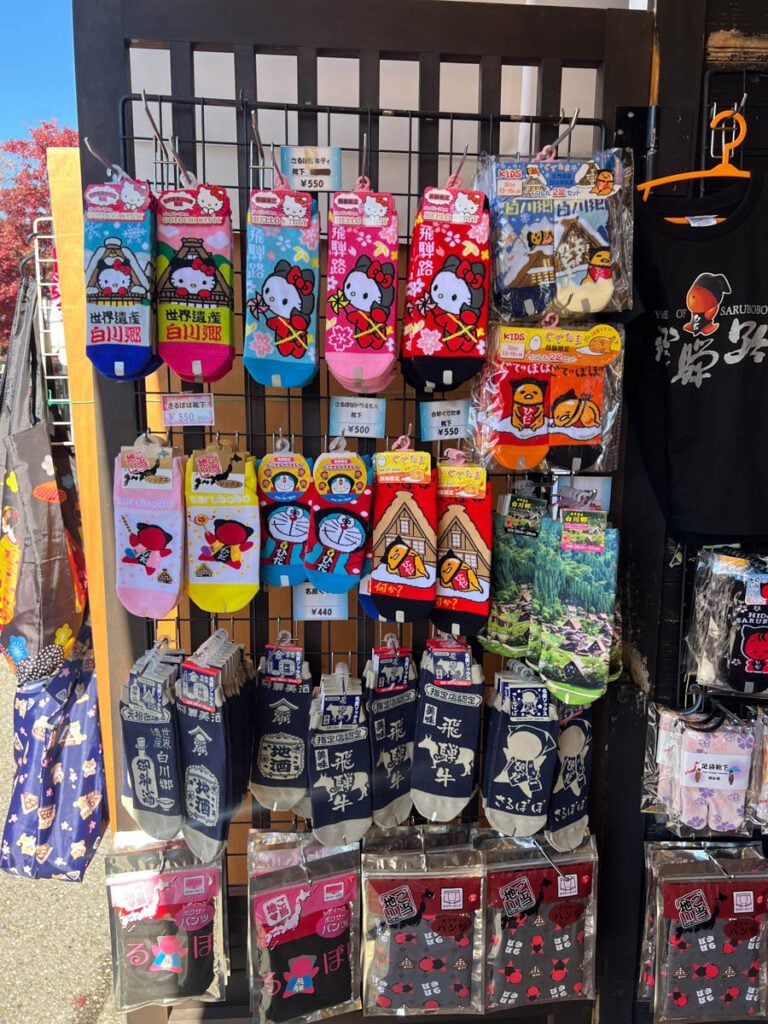
If you’re into fashion and you want to bring something home that you’ll actually use on a daily basis, you might consider getting clothing. Fun, quirky socks make a cheap (and practical) item to bring home from your trip to Japan. You’ll find all sorts of options to choose from.
Surprisingly, clothes in Japan are relatively inexpensive and shops are everywhere, including train stations.
33. Anything vintage
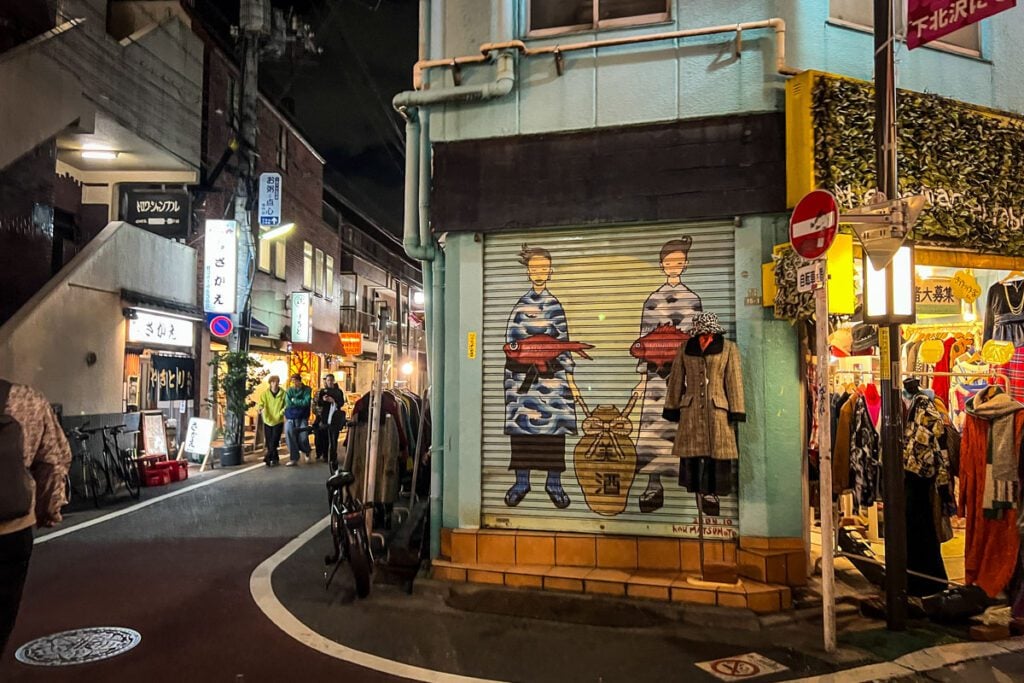
Japan’s big cities have a large number of vintage shops and they can be incredibly fun places to shop for souvenirs. From everyday clothing to vintage kimonos to ceramics, there’s a variety of wares you can shop for.
34. Kendama
This wooden game had short-lived popularity in the US back in the early 2000’s, but it’s still pretty easy to find in Japan. The point of the game is to swing the ball on a rope into the air and have it land in its correct place.
This could make a fun gift for any special kiddos back at home (or even for the kid at heart who needs a way to destress!).
35. Sarubobo doll
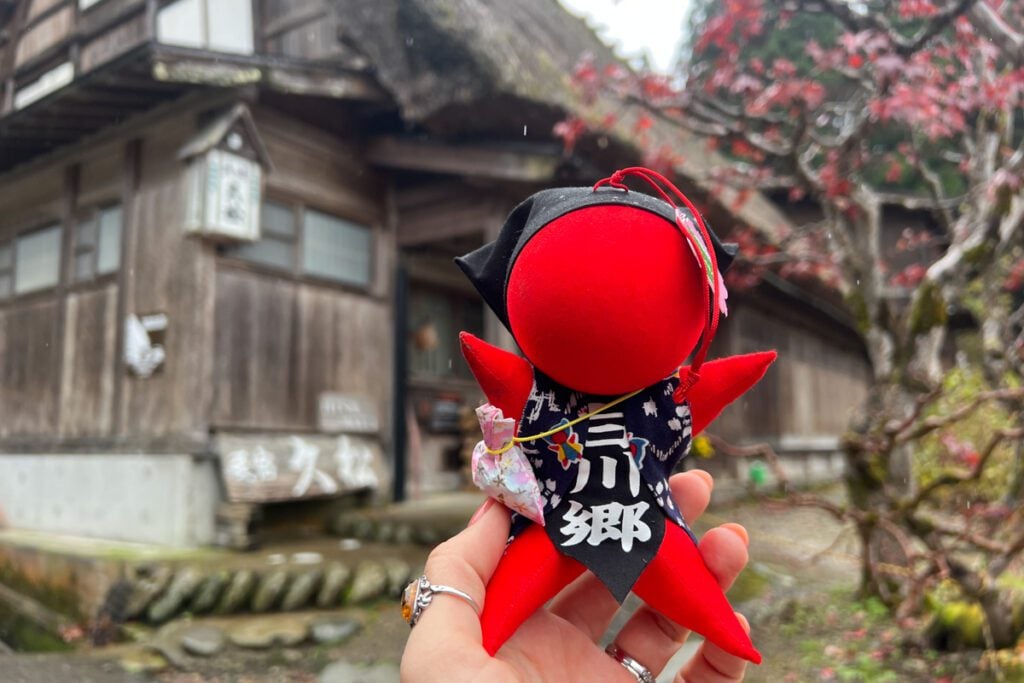
Sarubobo dolls are a traditional Japanese craft originating from the Hida region in Gifu Prefecture. These small, handcrafted dolls are characterized by their simple, faceless design and are traditionally made by grandmothers for their grandchildren.
The word “Sarubobo” combines “saru” (monkey) and “bobo” (baby) in the local dialect, symbolizing a monkey-faced baby.
To acquire a Sarubobo doll in Japan, visit local craft shops, souvenir stores, or markets while traveling in the Hida region.
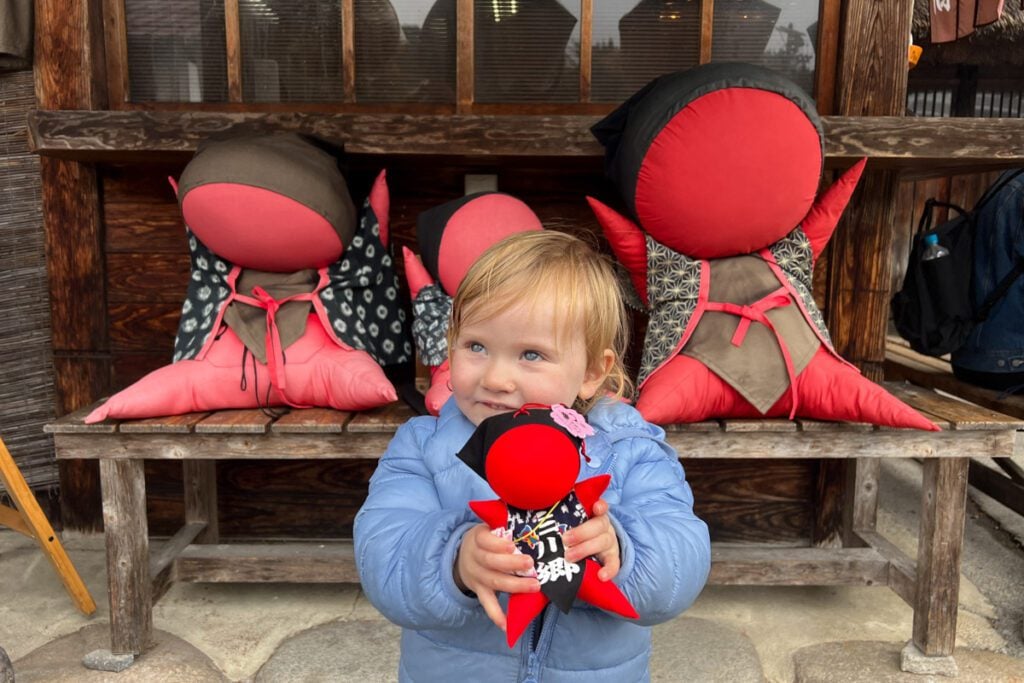
Both Shirakawa-go and Takayama in particular are known for crafts and are excellent places to find authentic Sarubobo dolls. Many shops offer a variety of colors, each carrying a different meaning—red for protection, pink for love, and white for purity.
Purchasing a Sarubobo not only makes for a great Japanese souvenir or gift, but also supports local artisans who have been creating these dolls for generations.
36. Japanese “mascots”
Japanese “mascots,” often known as yuru-chara or “local characters,” are whimsical figures created to represent different regions, cities, or provinces in Japan. These mascots play a significant role in promoting local tourism, culture, and products.
Each mascot is designed with unique characteristics and often reflects the distinct features or specialties of its respective region. You can usually find the mascots in stuffed animal form and other merchandise sold all over the region they represent.
Some notable examples include:
- Kumamon (Kumamoto): Kumamon is a black bear mascot representing Kumamoto Prefecture. With a friendly demeanor, Kumamon has gained widespread popularity and is one of Japan’s most well-known mascots.
- Sento-kun (Nara): Sento-kun is the mascot representing Nara Prefecture. As a cute and friendly deer character, Sento-kun pays homage to the famous wild deer that roam freely in Nara Park.
- Hikonyan (Hikone): Hikonyan is the mascot of Hikone City in Shiga Prefecture. This samurai cat gained fame for its historical significance, representing the city’s Hikone Castle.
- Funassyi (Funabashi): Funassyi is a pear fairy character representing Funabashi City in Chiba Prefecture. Known for its hyperactive and cheerful personality, Funassyi has become a cultural phenomenon.
- Yuru-chara Grand Prix: The Yuru-chara Grand Prix is an annual competition where mascots from different regions compete for popularity. Winners gain recognition and contribute to local tourism efforts.
37. Photos

Okay, this might sound like a cop-out, but honestly, our favorite souvenirs no matter where we are in the world are the photos we take. They remind us of special moments on our trip and they are uniquely ours. Plus, they don’t cost any money (other than the purchase of our phone/camera).
One fun thing you can do is to create a memory book from your trip to Japan. We think Chatbooks looks like a cool way to do it, but there are lots of companies out there!
Plan your trip to Japan
After 3 trips (and counting!), we’ve fallen head over heels for Japan—and we’ve gathered TONS of resources to help you plan your dream trip. Start with our Ultimate Japan Travel Guide and be sure to check out these helpful articles:
- First time? Our Japan Trip Planner walks you through everything you need to know.
- Use our Japan Rail Pass guide to determine if getting a train pass is optimal for your trip.
- Here’s our curated list of the best things to do in Japan—from iconic sights to once-in-a-lifetime experiences.
- Not sure where to go? Our Japan itinerary ideas will help you map it all out.
- Foodies, rejoice! This guide to what to eat in Japan will have you drooling before you land.
- This guide to what to wear in Japan (and what not to wear) will help you blend in.
- Use our ultimate Japan Packing List to make sure you don’t forget anything.
- Before you go, brush up on these essential Japan travel tips (including major do’s and don’ts!).
- Avoid awkward moments by brushing up on Japanese etiquette.
Still have questions? Drop us a comment—we LOVE helping travelers plan unforgettable trips to Japan!
Perfect Japan itinerary
Want the perfect itinerary planned for you?

If you don’t have a ton of time to spend planning your Japan itinerary (or you just don’t find travel planning fun), we’ve got something you might be interested in…
We created the ultimate done-for-you Japan itinerary that is packed full of all sorts of tips we’ve gathered from 3 trips to Japan as well as literally hundreds of hours of research (no exaggeration).
We have both an off-the-beaten path route as well as a classic itinerary that hits the top attractions (perfect for your first visit to Japan!).
Don’t miss your chance to grab our Japan Pocket Guide!
This (totally FREE!) pocket guide is a condensed version of all the things you should know BEFORE & DURING your trip to Japan!
Just enter your email and we’ll immediately send our pocket guide straight to your inbox!
Save this article to Pinterest!
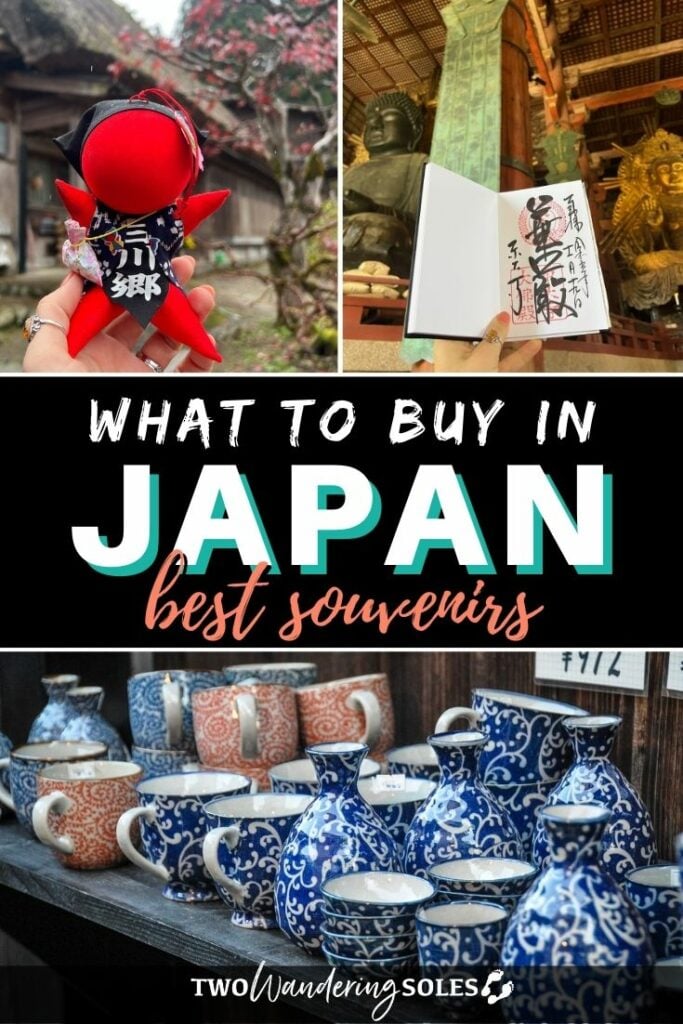
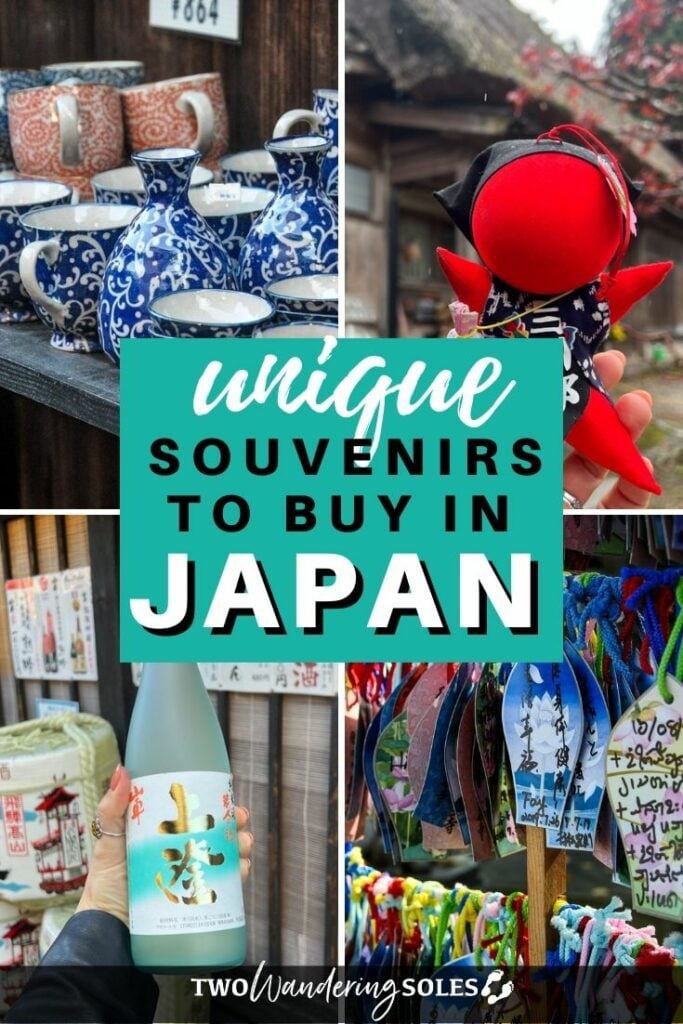
We want to hear from you!
Are you planning a trip a wondering what to buy in Japan? We sincerely hope this guide is helpful and gives you some unique inspiration for Japanese souvenirs. Leave your comment below and we’ll do our best to get back to you!

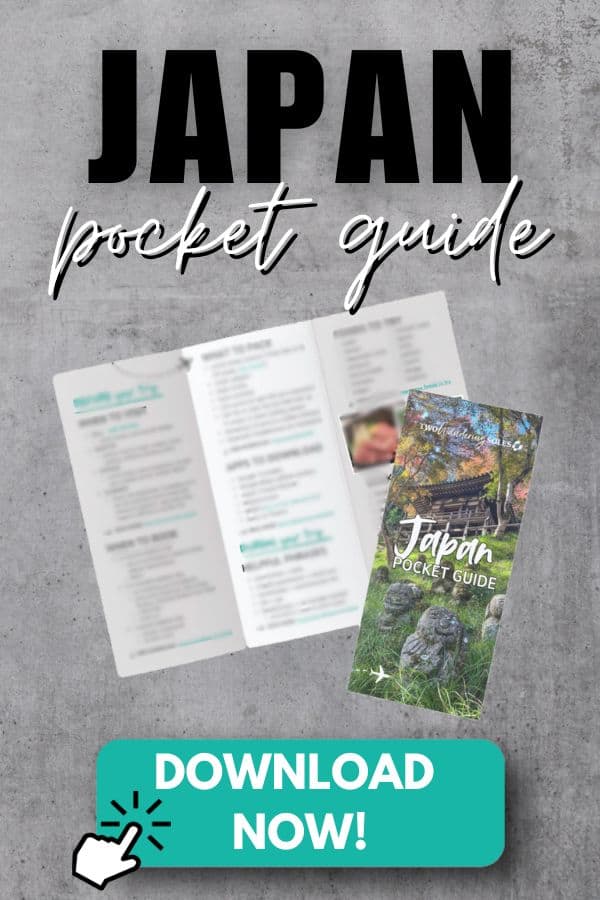
Wow
Your western names cannot be “translated into kanji” accurately FYI lol you do not have a Japanese name it won’t be in kanji, maybe the sound in hiragana or katakana but not Kanji lol
I’ve played with a Kendama and it gets so addicting! It’s crazy how it’s all really in the legs! Lol! One of my favorite Japanese souvenirs is definitely the handmade ceramic teacups I got in Okinawa (:
I always struggle with buying souvenirs. I want a keepsake from our travels, but I don’t want it to be useless. These are great ideas!
Some great souvenirs mentioned in your post. Many are small and can easily be carried around. I love the bowls. I bought some myself and often use them.
Great post! I bought some ceramic bowls when I was in Japan and love them. They are the perfect size and always remind me of my trip.
I can see visiting Japan would be bad for both my bank balance and storage space in my home… but I still want to go. These all look amazing
I love what you guys do and all the great content you put out, but this post rubs me the wrong way 🙁 Buying cheap, plastic souvenirs is not responsible travel. I love that you included things like ceramic bowls, cooking class experiences, and other ‘thoughtful’ reminders of what makes the culture in Japan amazing. But do travelers really need a sushi magnet that will end up in a landfill or a plastic name stamp that they will never use?
Hey Becky, Thank you for focus on responsible travel. We always try our best to travel consciously and thank you for keeping us in check.
We added the magnet because it something that is quirky, cute and totally Japanese. There are many things like this that are not plastic and we would encourage travelers to avoid plastic items when they can. But we did have a family member in mind to gift this magnet too, and we know he will use it for many, many years (he is a lover of all things quirky).
As for the name stamps, we were both gifted name stamps from our co-teachers when we were living in South Korea (also a big thing in Japan) so this item has a huge sentimental value for us. The name stamps we have (and the ones we highlight in the article) were hand-crafted and made out of wood with a small piece of rubber for the stamp.
I hope this clarifies things a bit. Thank you again for your focus on sustainable and responsible travel.